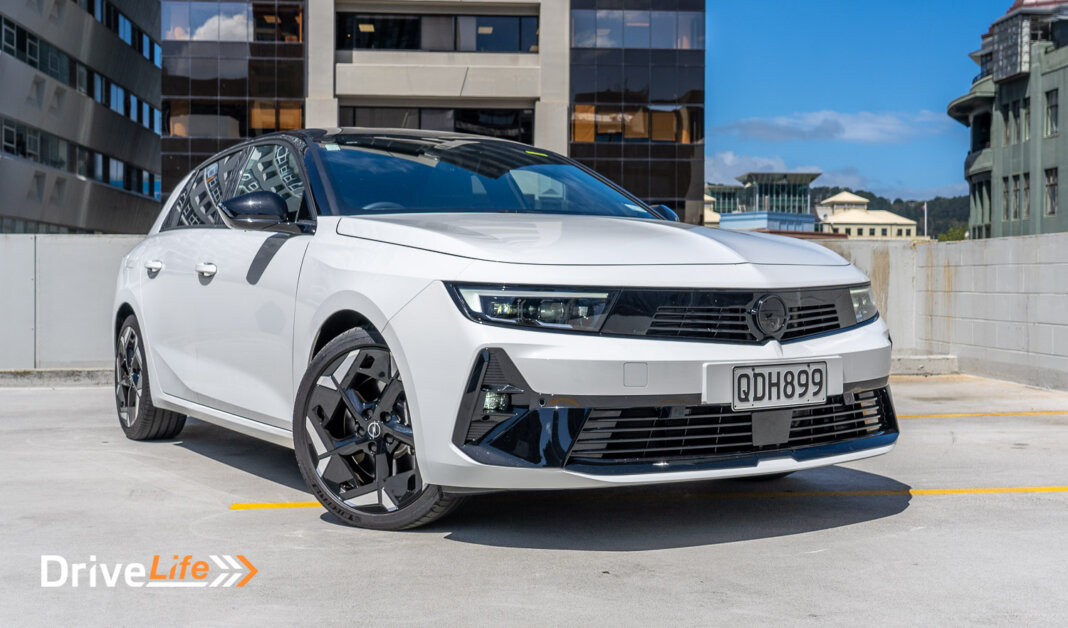Plug-in hybrids (PHEVs) have had some bad press lately, with the upcoming application of Road User Charges (RUCs) to any PHEVs putting a dent into their desirability.
There have been stories of PHEV owners blocking off the charging port to avoid the RUCs, but should they? Is running a PHEV that bad a deal when you add RUCs to the equation?
DriveLife spent a week in the 2024 Opel Astra Grand Sport Electric, a plug-in hybrid that should, according to Opel, use just 1.0L/100km of petrol. We drive the car for 500km and do the financial math for you.
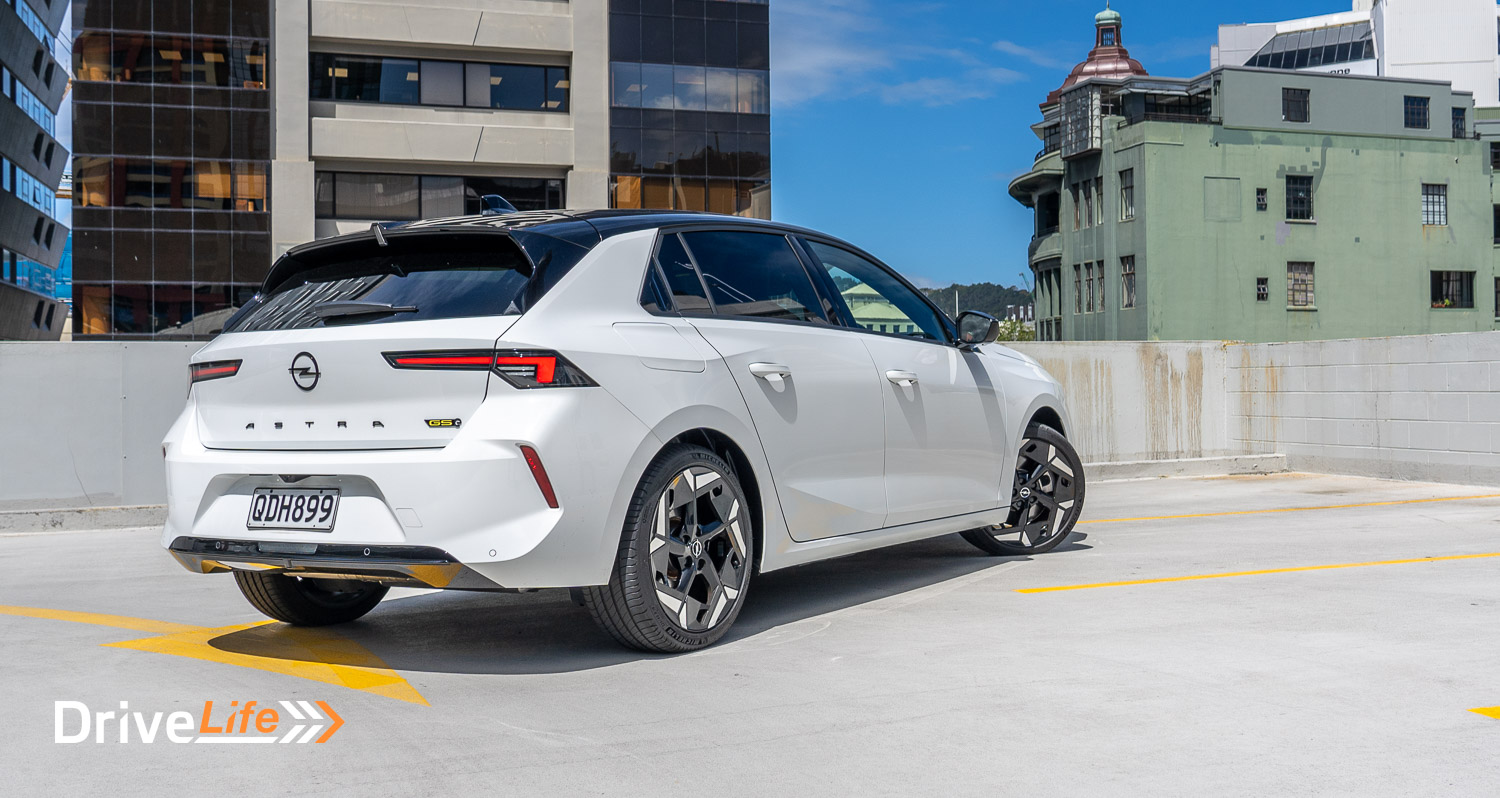
What We Like and Dislike About The 2024 Opel Astra GSe
| What we like | What we don’t like |
| Electrified gearbox Fuel economy Handling/road holding Ride quality Performance in EV or Sport mode Car remembers drive mode EV-only range Standard features Design Walk-away lock/unlock | Turning the car off and on is a bit painful Dark in the rear of the car Price Headroom in rear |
What’s In The 2024 Opel Astra GSe Range?
There are two models in the Astra range in New Zealand, the SRi (petrol) and GSe (plug-in hybrid).
The SRi is priced at $49,990 and has a 1.2-litre, 3-cylinder turbocharged petrol engine that manages to output 96kW of power and 230Nm of torque. It’s mated to an 8-speed automatic transmission. Fuel economy is listed at 5.1L/100km.
The GSe is powered by a 1.6-litre, 4-cylinder petrol motor and along with that is an 81kW/320Nm electric motor to give a combined rating of 165kW of power and 360Nm of torque. The power and torque of the petrol engine alone are not stated and this model is priced at $71,990.
The GSe has a 12.4kWH battery pack to give up to 61km of electric-only range and the car is rated to give 1.0L/100km of petrol used.
Both petrol and electric models are connected to an 8-speed automatic transmission and both the SRi and GSe are front-wheel drive.
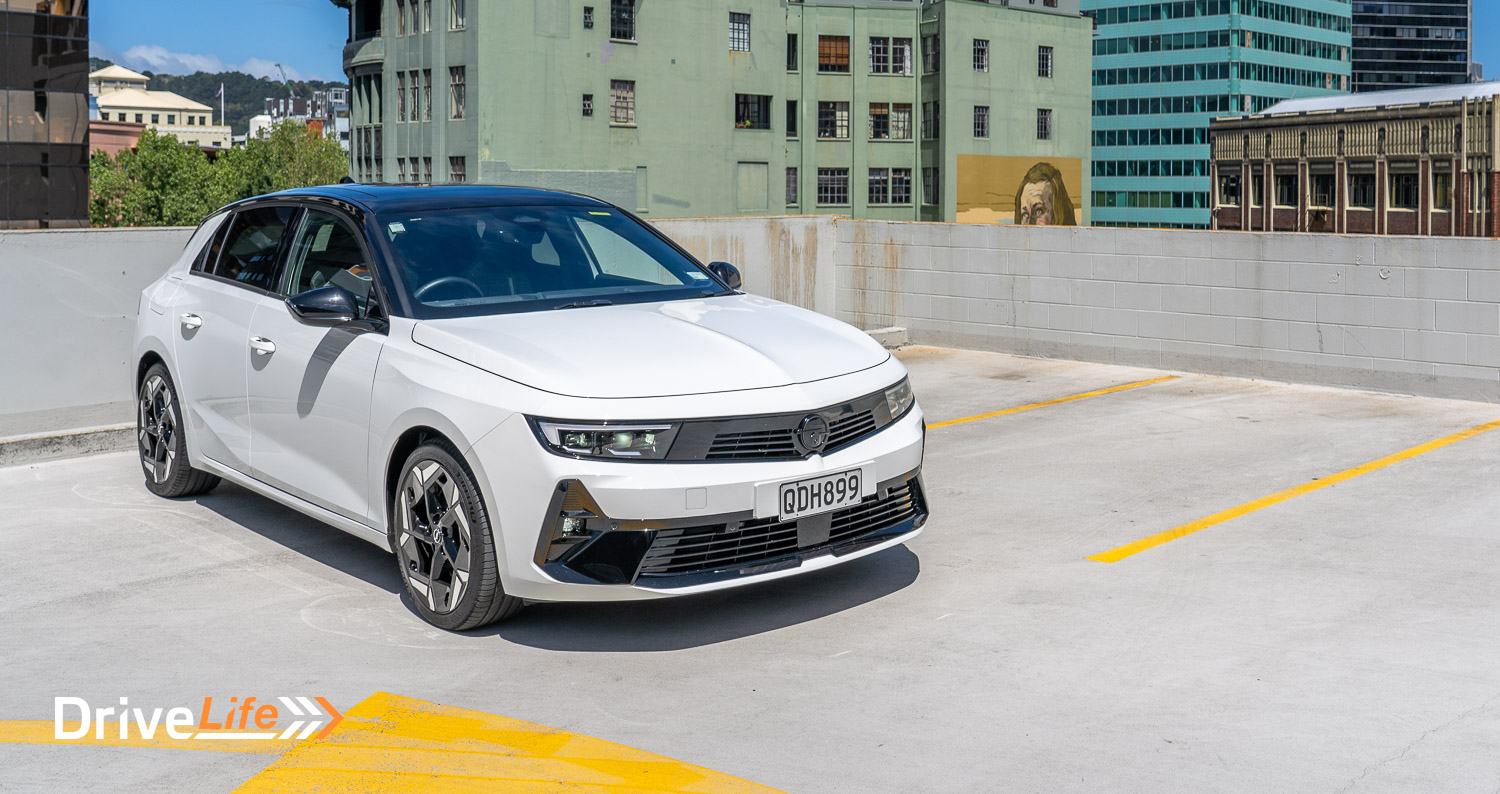
2024 Opel Astra Standard Equipment Highlights
Opel Astra SRi:
- Tyre Pressure Monitoring
- Adaptive cruise control with stop/go
- Speed Limiter
- Lane Keep Assist with Road Edge Assist
- Lane Positioning Assist
- Rear Cross Traffic Alert
- Traffic Sign Recognition
- Advanced Active Emergency Braking with night function and pedestrian/cyclist detection
- Long-range blind spot monitoring
- Driver Attention Alert
- Forward Collision Warning
- Adaptive LED headlights
- LED DRLs
- LED front dog lights
- LED taillights
- Automatic headlights
- Automatic wipers
- Welcome and Follow Me Home light function
- 18” diamond cut alloy wheels
- Heated steering wheel
- Black Alcantara and leatherette trim
- Electric driver’s seat
- Heated front seats with electric lumbar adjust
- Dual-zone AC
- Heated and electrically folder exterior mirrors
- Hill start assist
- Front and rear parking sensors
- 360-degree camera
- Keyless entry and start
- Wireless Apple CarPlay and Android Auto
Opel Astra GSe adds:
- GSe-specific AGR ergonomic sports-style front seats
- Heads-up display
2024 Opel Astra Colour Range
The Astra range is available in one of seven colours;
- Amber Yellow Metallic
- Carbon Black Metallic (+$550)
- Crystal Silver Metallic (+$550)
- Jade White (+$550)
- Vulcan Grey Metallic (+$550)
- Cobalt Blue Peralescent (+$950)
- Ruby Red (+950)
Our test car was finished in Jade White, so with that extra cost the car’s as-tested price is $72,540.
For a full list of specs and options available for the Opel Astra GSe head on over to the Opel New Zealand website.
How Does The 2024 Opel Astra GSe Compare To Its Competition?
It may be at the bottom of our comparison table, but one thing is for certain: plug-in hybrid models are so much more expensive than their petrol-only stablemates.
| Make/ Model | Engine | Power/ Torque kW/Nm | Seats | Fuel L/100km | Boot Space litres | Price |
| Cupra Formentor V e-HYBRID | 1.4-litre, 4-cylinder petrol/plug-in hybrid | 180/400 | 5 | 1.3 | 345 | $78,900 |
| BMW 225e Active Tourer (station wagon) | 1.5-litre, 3-cylinder petrol/plug-in hybrid | 180/477 | 5 | 1.1 | 406 | $78,500 |
| Volkswagen Golf GTE | 1.4-litre, 4-cylinder petrol/plug-in hybrid | 180/400 | 5 | 1.2 | NA | $75,990 |
| MINI Countryman | 1.5-litre, 3-cylinder turbochargeded petrol/plug-in hybrid | 165/385 | 5 | 2.4 | 405 | $75,850 |
| Peugeot 308 GT PHEV | 1.6-litre, 4-cylinder petrol/plug-in hybrid | 165/360 | 5 | 1.0 | 361 | $74,990 |
| Skoda Octavia iv Style (station wagon) | 1.4-litre, 4-cylinder petrol/plug-in hybrid | 150/350 | 5 | 1.0 | 490 | $71,990 |
| Opel Astra GSe | 1.6-litre, 4-cylinder petrol/plug-in hybrid | 165/360 | 5 | 1.0 | 352 | $71,990 |
Please note that DriveLife does its best to ensure the information above is correct at the time of publication, however, prices, specifications and models can change over time. Please bear that in mind when comparing models in the comparison table.
First Impressions Of The 2024 Opel Astra GSe
I think one of the most surprising things about the Astra GSe is just how good it looks. When you look at the Peugeot cars that Opels are based on, well, Peugeot does an amazing job of car design – they look stunning, every model.
So to take that amazing-looking car design and change it is a hard road. But for the Astra, Opel has created something different, good-looking, and almost as good as the (for example) Peugeot 308 it’s based on. That in itself is a feat of design.
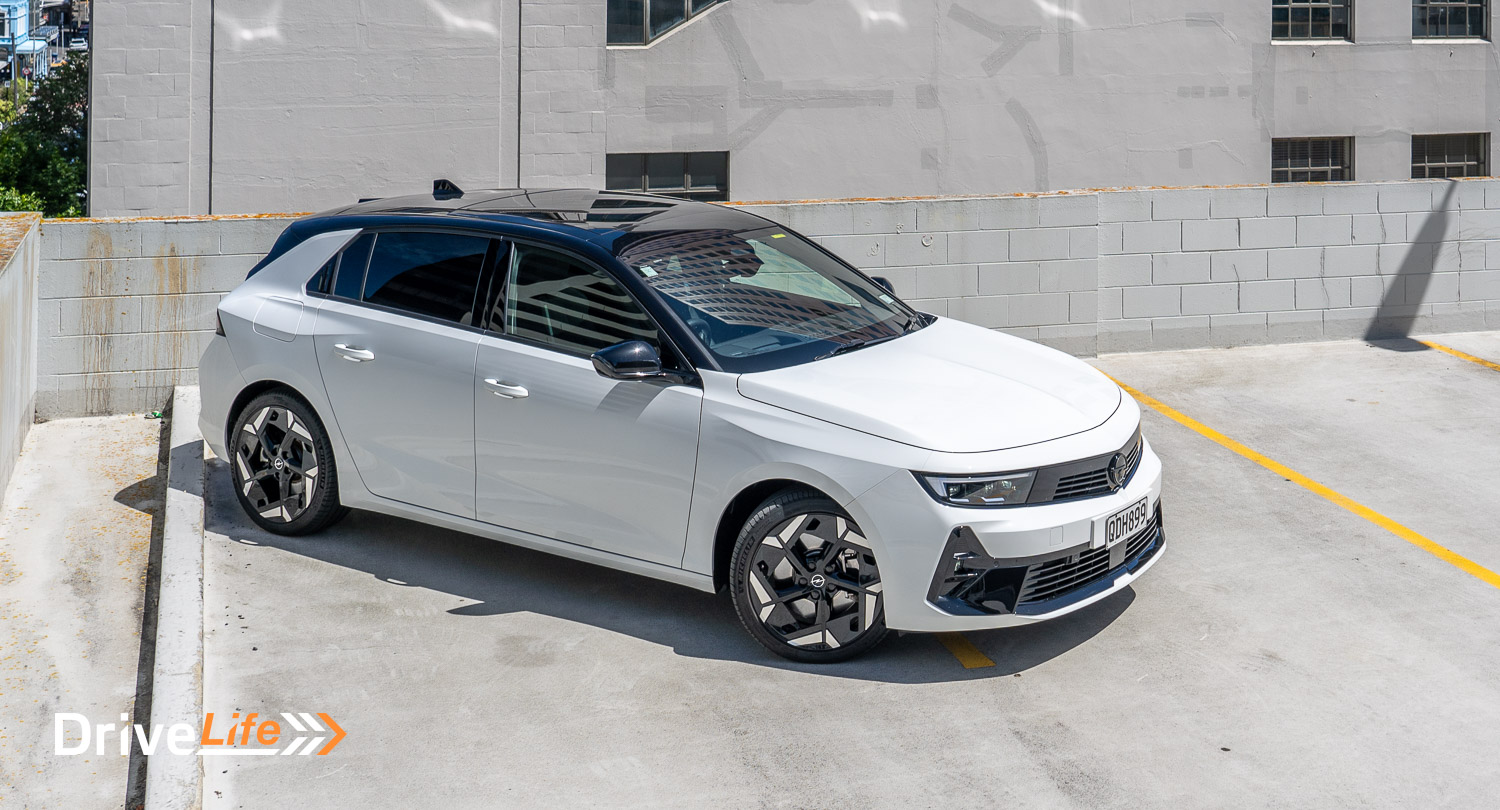
Those good looks aren’t just reserved for the front. Side-on, it’s nicely proportioned with just the right lines and creases, allowing it to look modern and sporty. Those 18” rims and lowered stance add to the side-view sportiness.
That theme continues around the back where you’ll find very sexy taillights (yes, I know, but taillights can look sexy!) that include tiny indicators that are similar to a certain American EV brand that shall not be named.
There is no denying the 2024 Opel Astra GE3 is a great-looking car. And it’s a hatchback and not an SUV, always a win in my book.
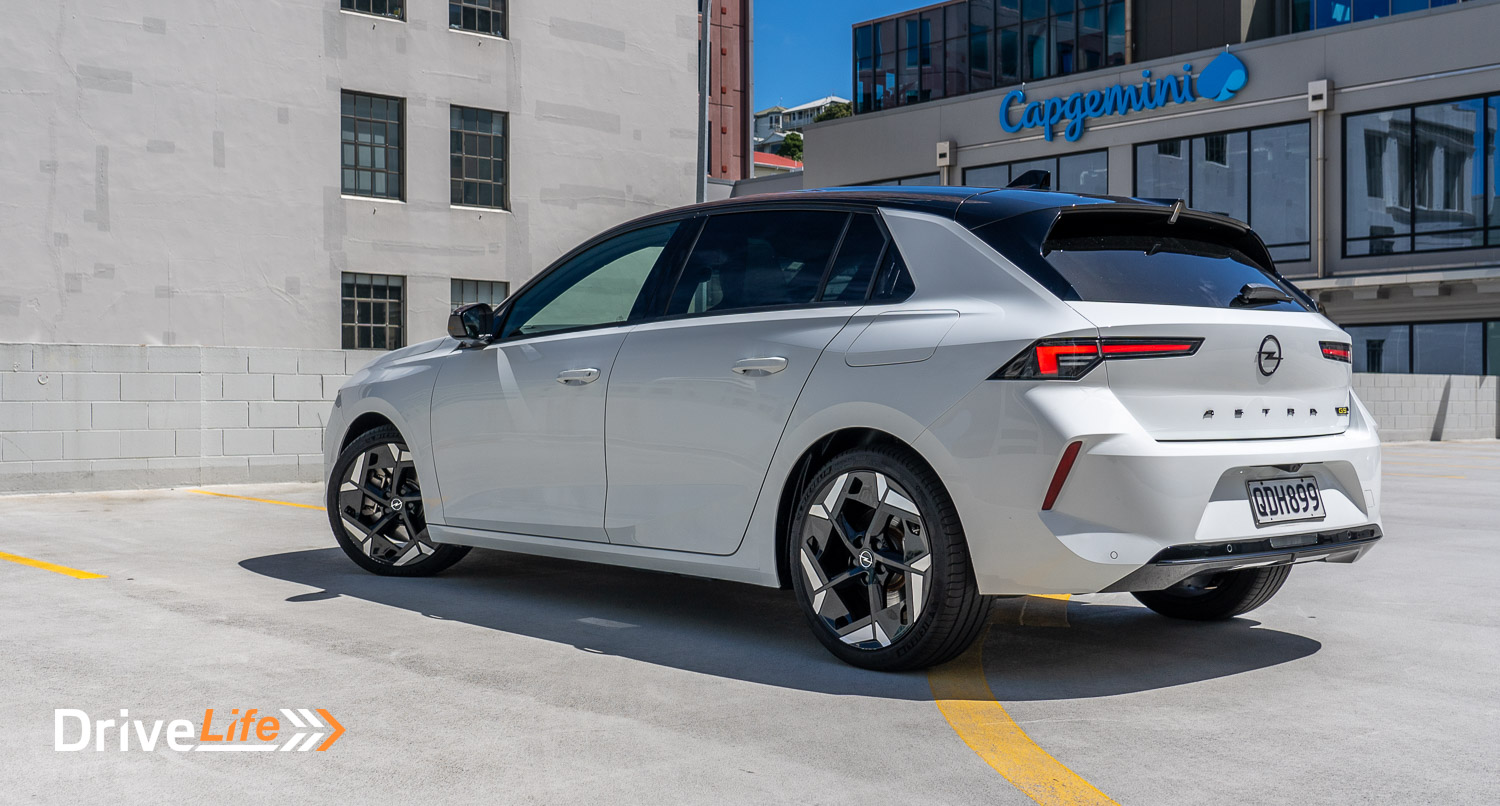
What’s The Interior Like In The 2024 Opel Astra GSe?
The sporty theme continues on the inside of the Astra, with single-piece front seats with a ‘GSe’ logo at the top. The entire interior is finished in black, so it can feel pretty closed in at times. There is an electric sunroof with a manual blind so there is the option to leave the blind open but with the 25+ degrees during our week of testing, keeping that blind shut was a priority.
In the front, there’s plenty of headroom, and facing you is a wrap-around design containing the dashboard and centre touchscreen display. It looks quite impressive but the centre display is ‘only’ 10”, so it doesn’t take up all of the space available.
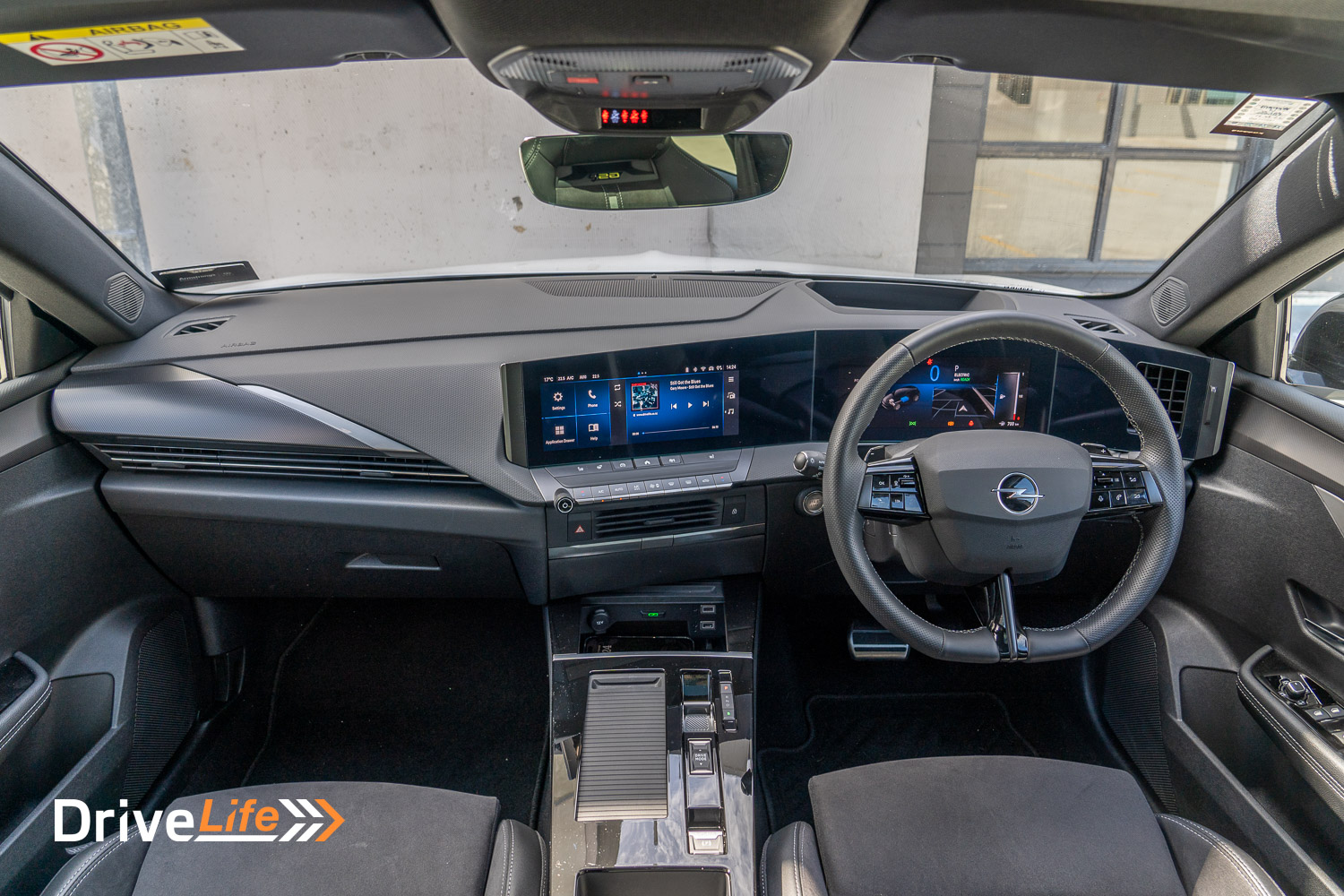
It’s fantastic to see physical AC controls in yet another test car; I had just handed back the Hyundai Kona Limited 1.6T AWD and it too had actual buttons for controlling the air in the car. I thought these were endangered but it was awesome to see Opel maintaining the common-sense approach to AC controls. These aren’t simple dials and knobs in the Astra, but still better than AC controls that can only be accessed from a screen.
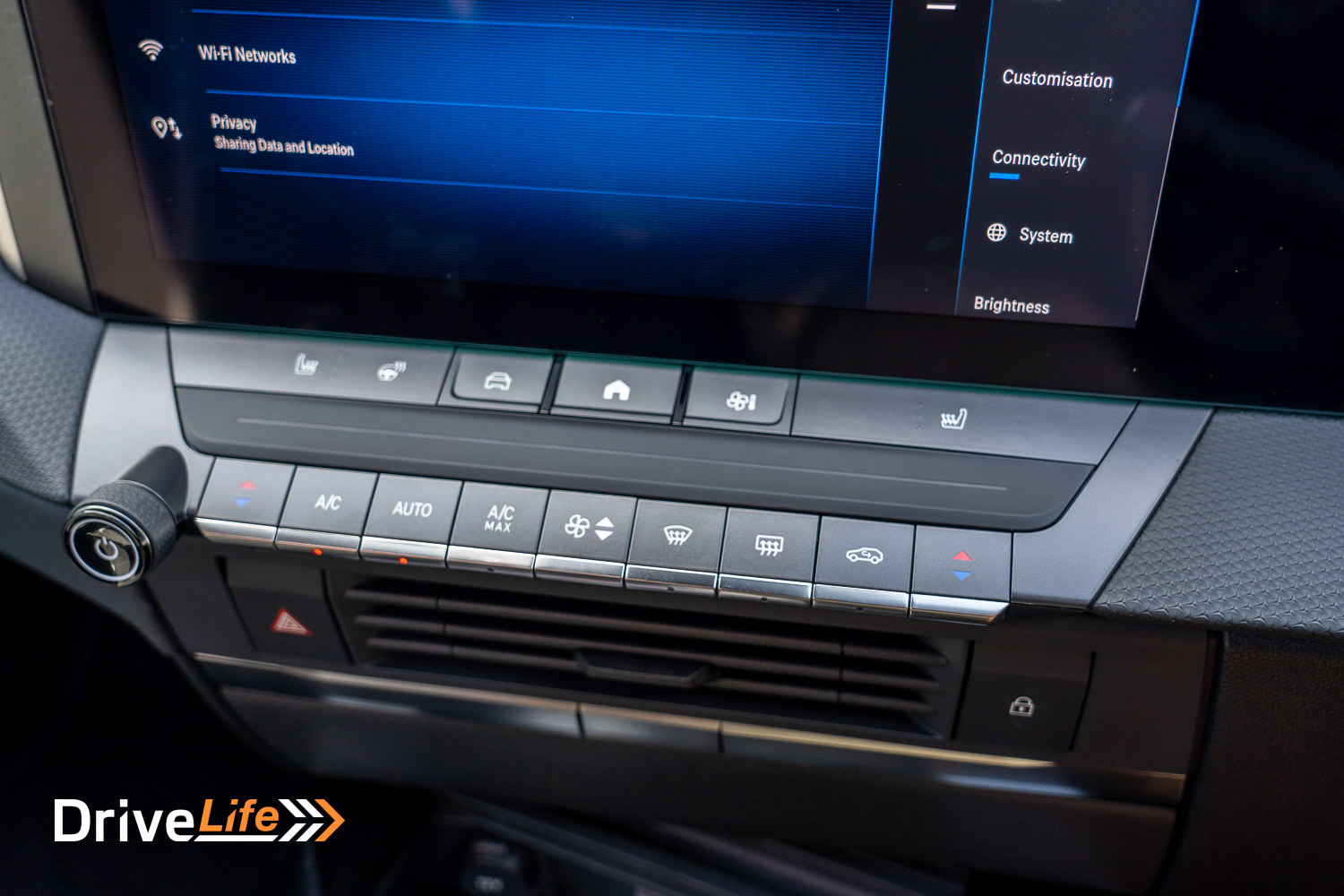
Below the AC controls is a first for me; a pop-out sunglasses holder. Normally, these are up by the mirror so I had to think what this holder was for, for a while. It’s almost hidden, like a place to put your valuables away from prying eyes.
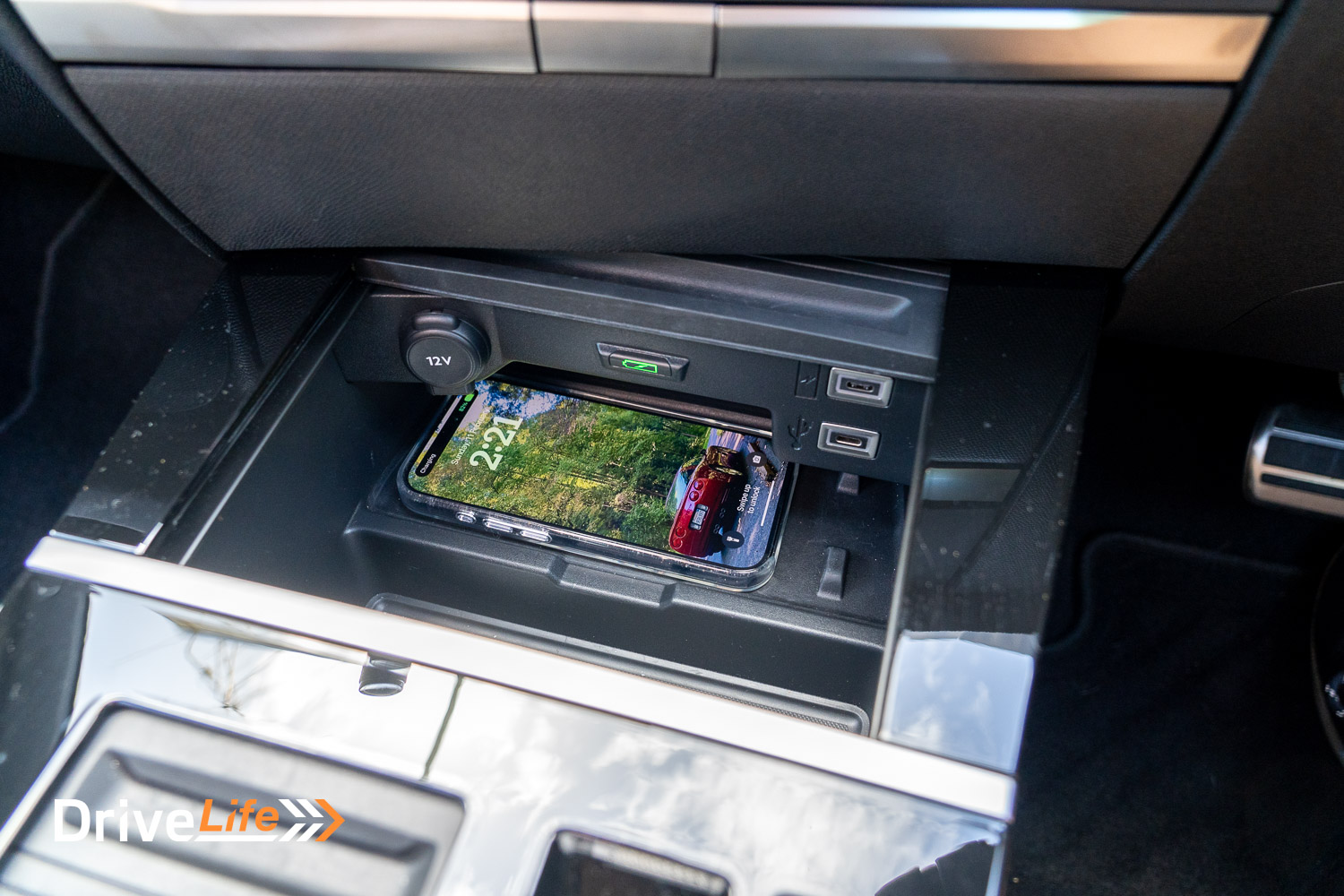
Below this is the front of the centre console, with a recessed area for your cellphone that also has a Qi wireless charging pad. It’s a long way down and forward, but it works. Just in front of the charger is a storage area, with some hidden areas of its own. I found a pair of Airpods hidden away here, where they were completely out of view. You’ll find a 12-volt socket and two USB-C ports here too.
Like Peugeots and Citroens that the Astra is based on, on the piano black console there is a drive selector instead of a lever. It works well enough, although for my short arms at times it feels like a bit of a reach, especially when I’m doing a 3-point turn and want to change between Reverse and Drive quickly. Further back again is a shallow but usable cubby.
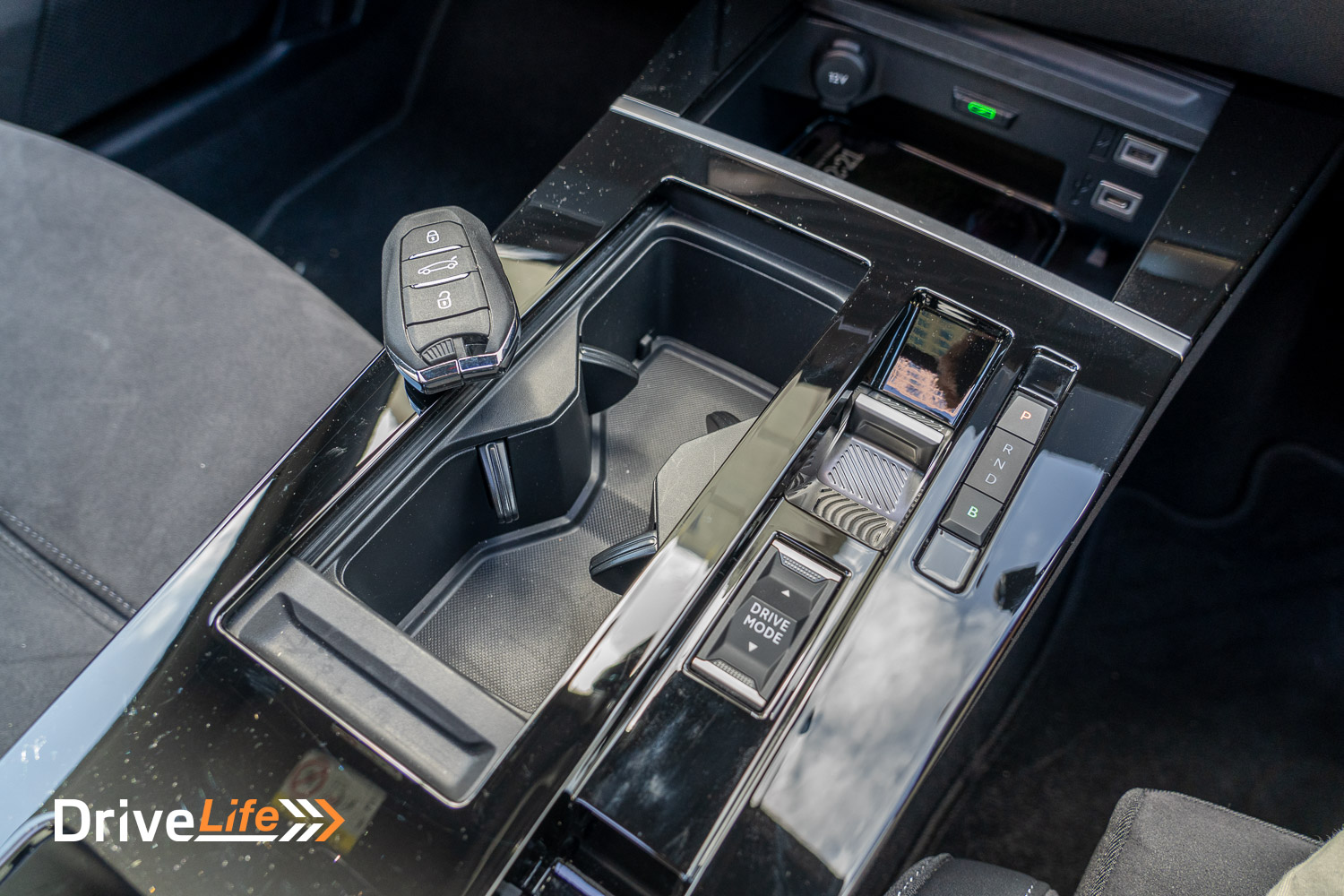
It’s great to see a full-size glovebox on the Astra when its brethren often have a half-width glovebox instead.
Those one-piece seats are finished in Alcantara and are electric in the front. The driver also gets 4-way electric lumbar adjustment, two memory positions, and a manually extending seat cushion. Both front seats have 3-stage seat heating, and the driver gets a single-stage heated steering wheel.
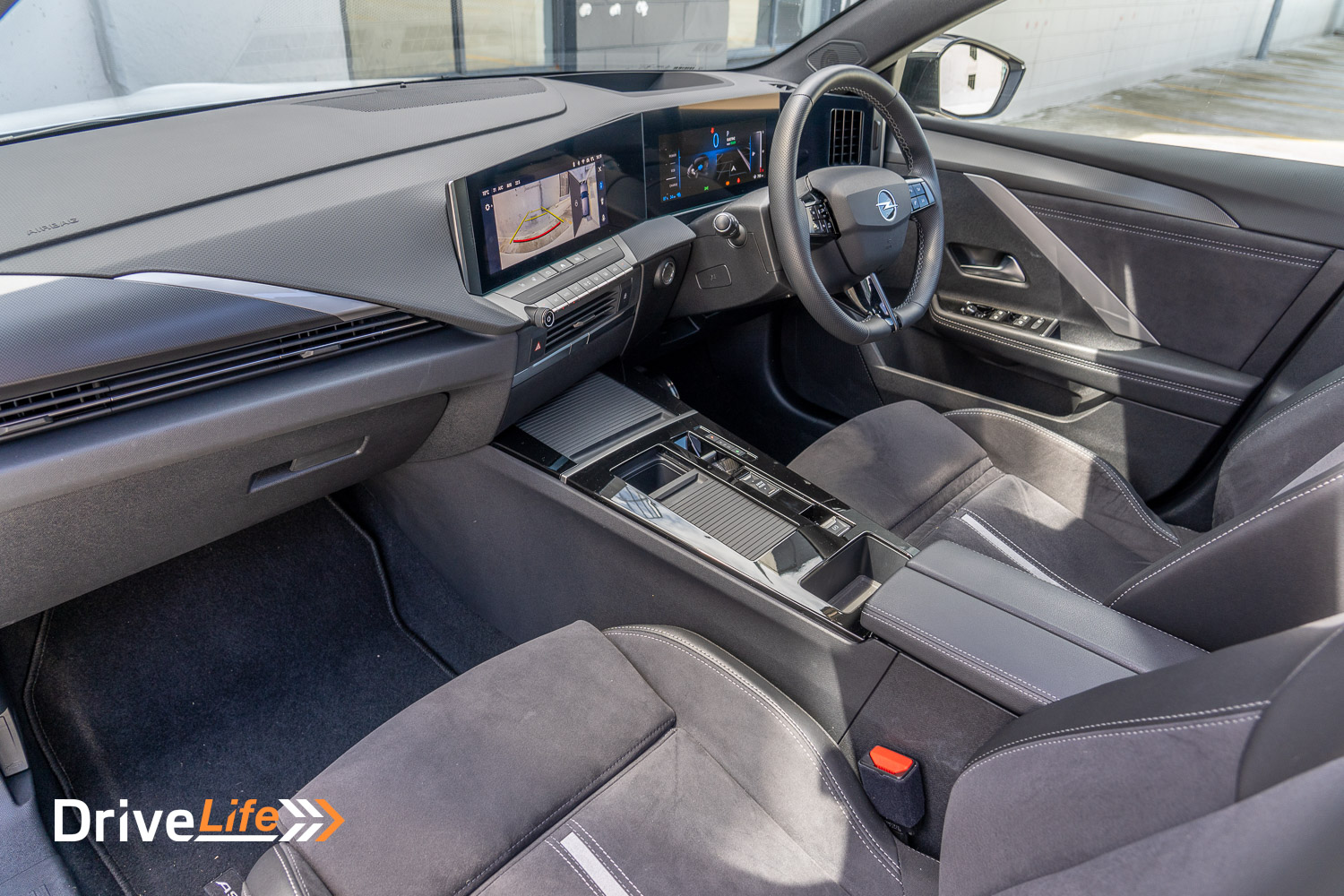
The doors have some nice, soft touchpoints to them, although the front of the doors is all flat black plastic and looks a little cheap.
Rear seat passengers don’t fare quite so well as the front, with reduced headroom and that, along with those single-piece front seats, means it can feel a little claustrophobic back there. Twice I had passengers in the rear seats, and both times they mentioned that feeling of limited space. As a bonus though, rear-seat passengers do get their own air vents and a single USB-C port for charging devices.
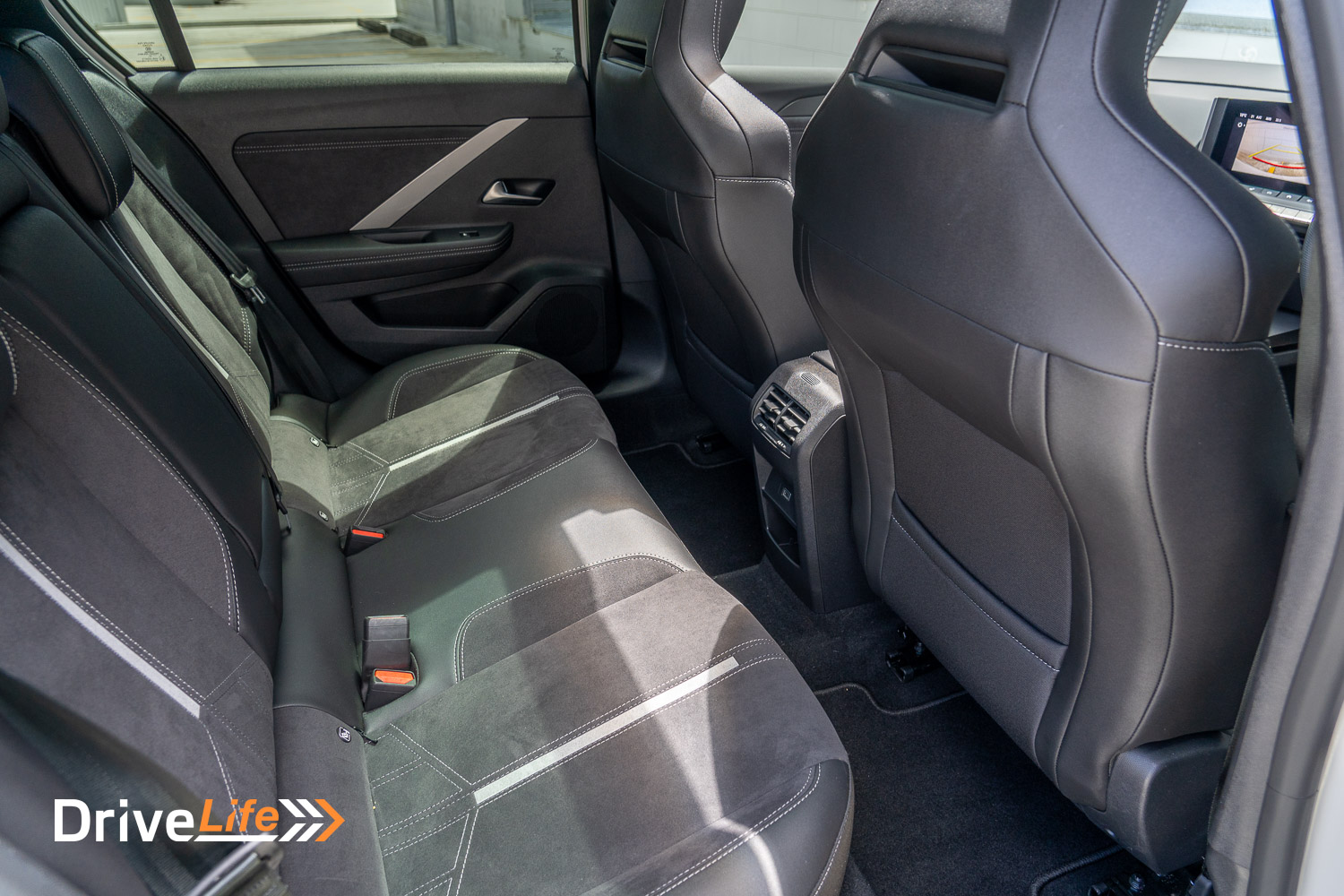
The boot is a usable 352 litres, and there’s also a shallow storage area under the floor. The tailgate on the Atra GSe is a manual one, but it’s well-weighted.
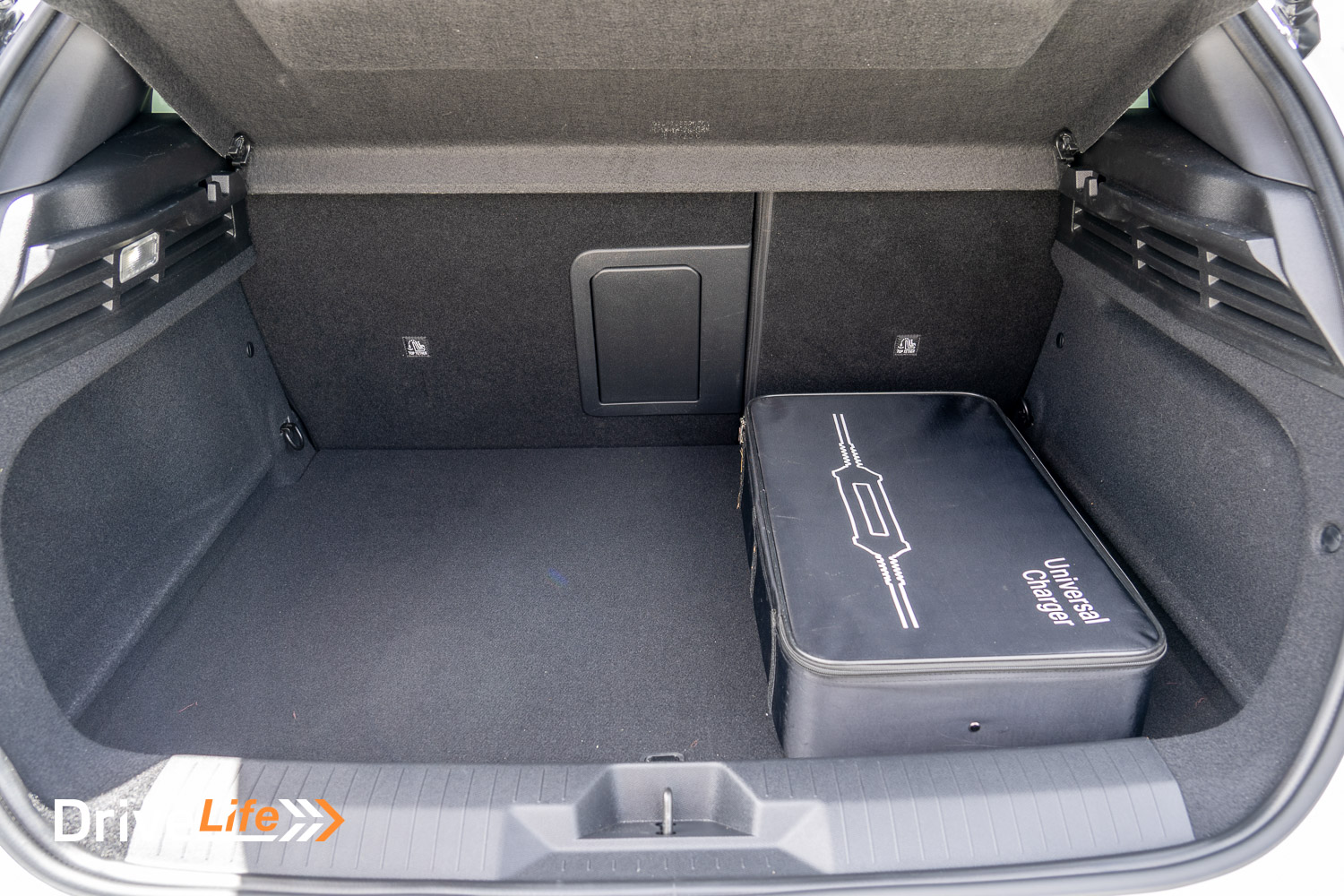
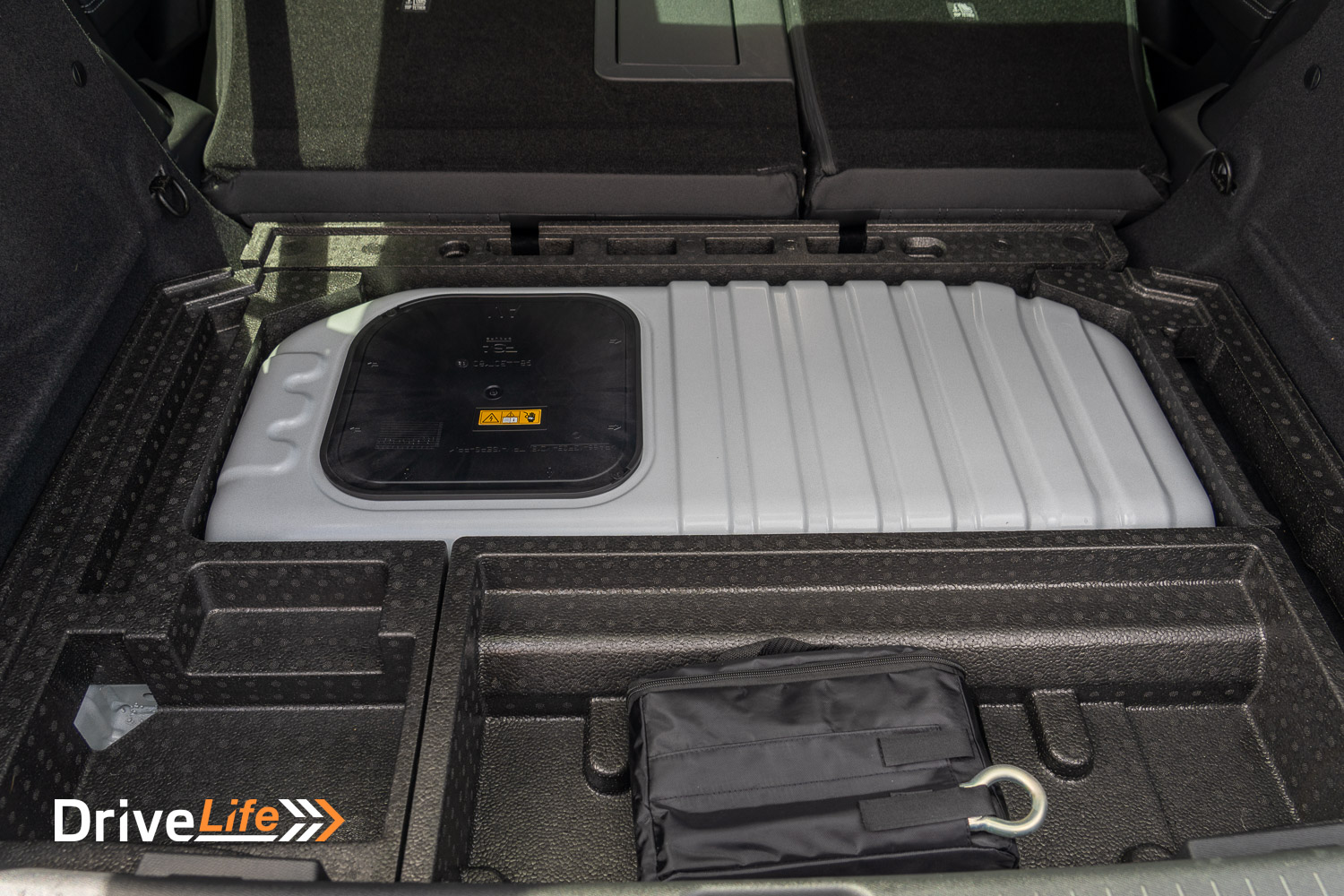
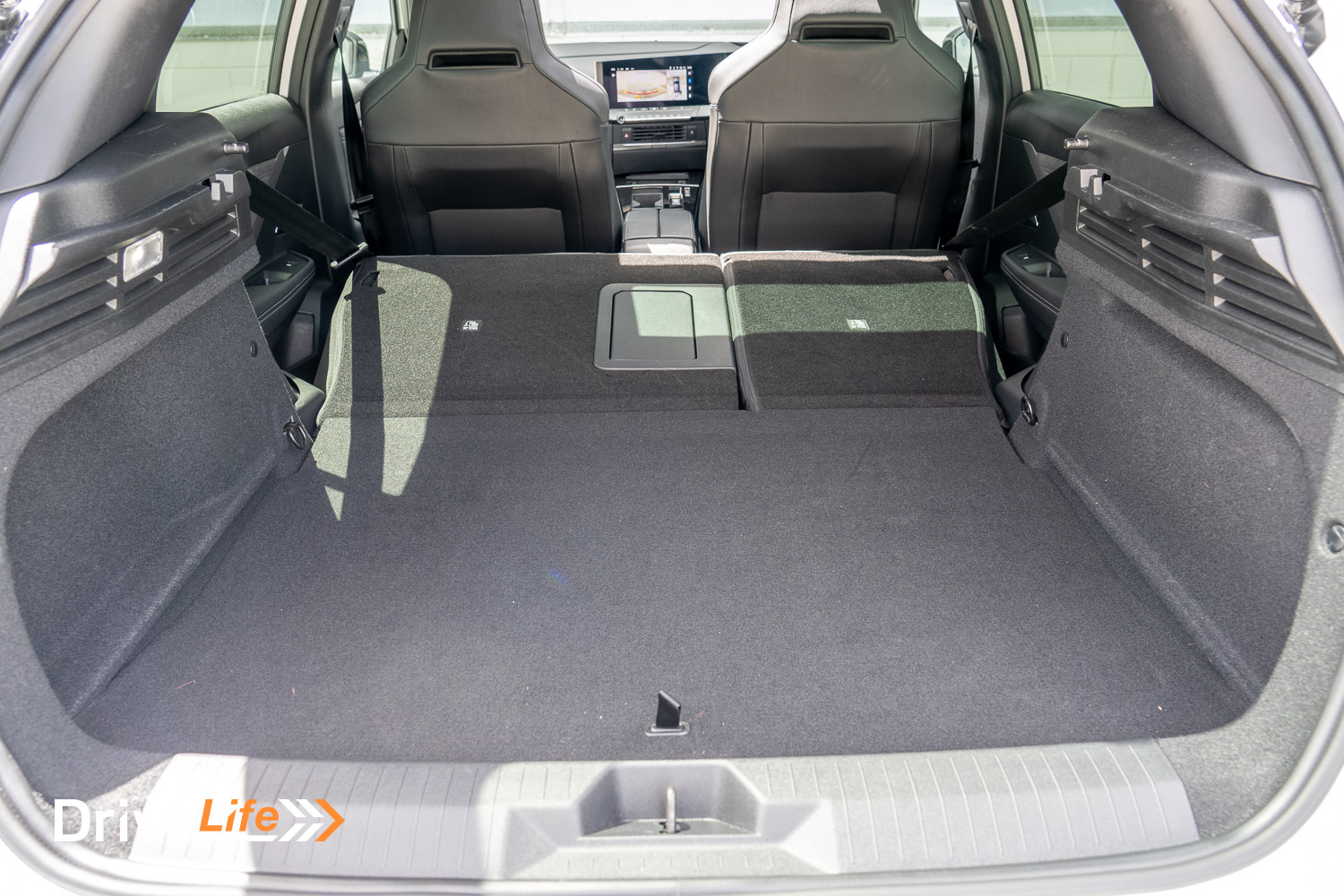
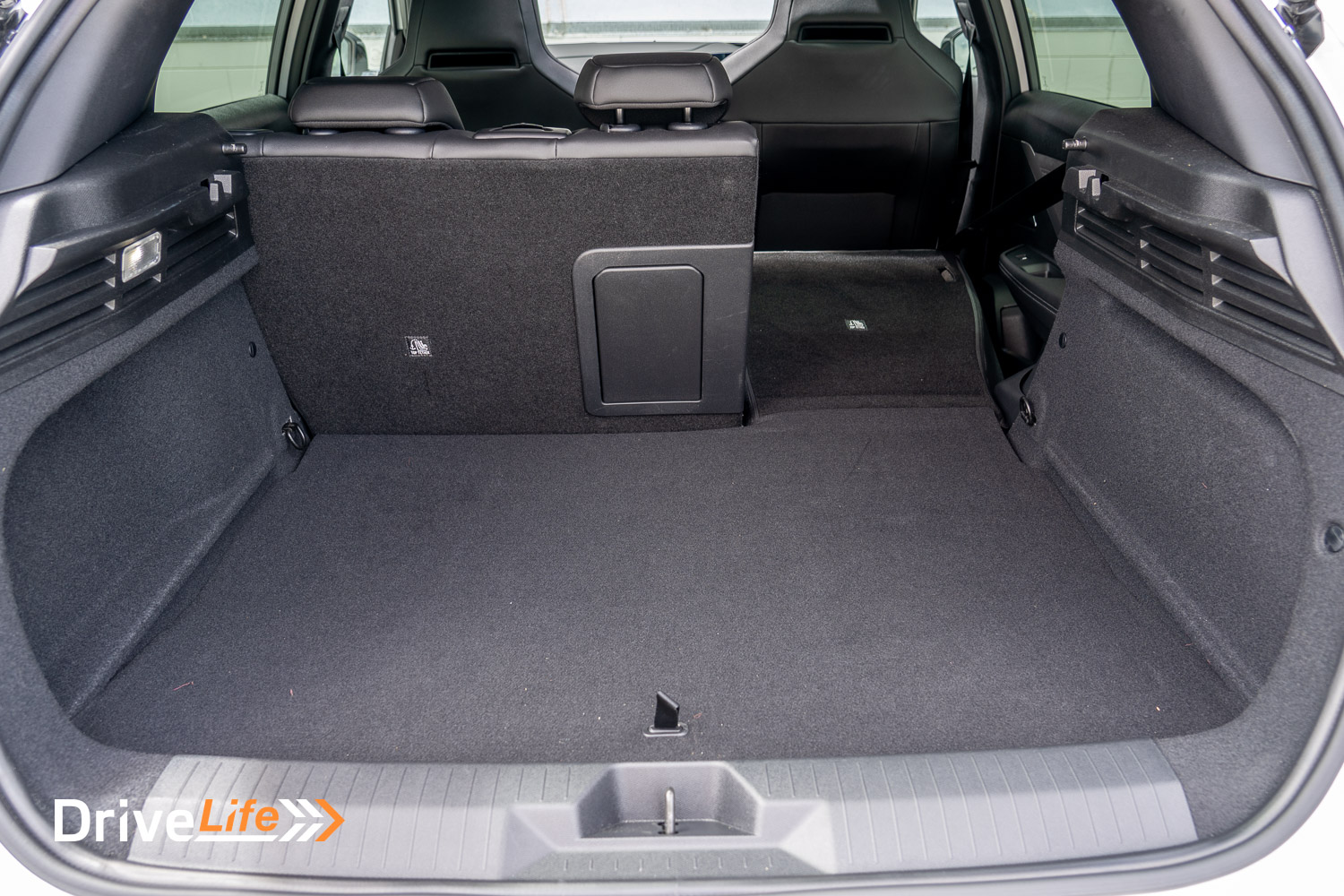
What’s The 2024 Opel Astra GSe To Drive?
On picking up the GSe, the range was showing as a total of 700km and an EV-only range of 36km. Since this car is supposed to do up to 61km on a single charge, I think someone had been driving it a little hard.
I hate to start with something negative, but this “feature” applies to Opels, Peugeots, and Citroens; you have to hold the on/off button for the car down for 3 seconds for it to turn on, or off. First-world problems and all that, but it’s a little painful. Too many times I had (I thought) turned the car off and then get out only to find it wouldn’t lock, since the car was still on. I desperately wish this would be changed to be the same as every other car with keyless start. Perhaps after a while of ownership, this would become second nature.
On the plus side, I love that the Astra GSe has walk-away locking, and walk-up unlock. I know, it’s so lazy, but being able to simply walk away from the car and let it lock itself is a nice efficiency. Well, as long as you have turned it off properly.
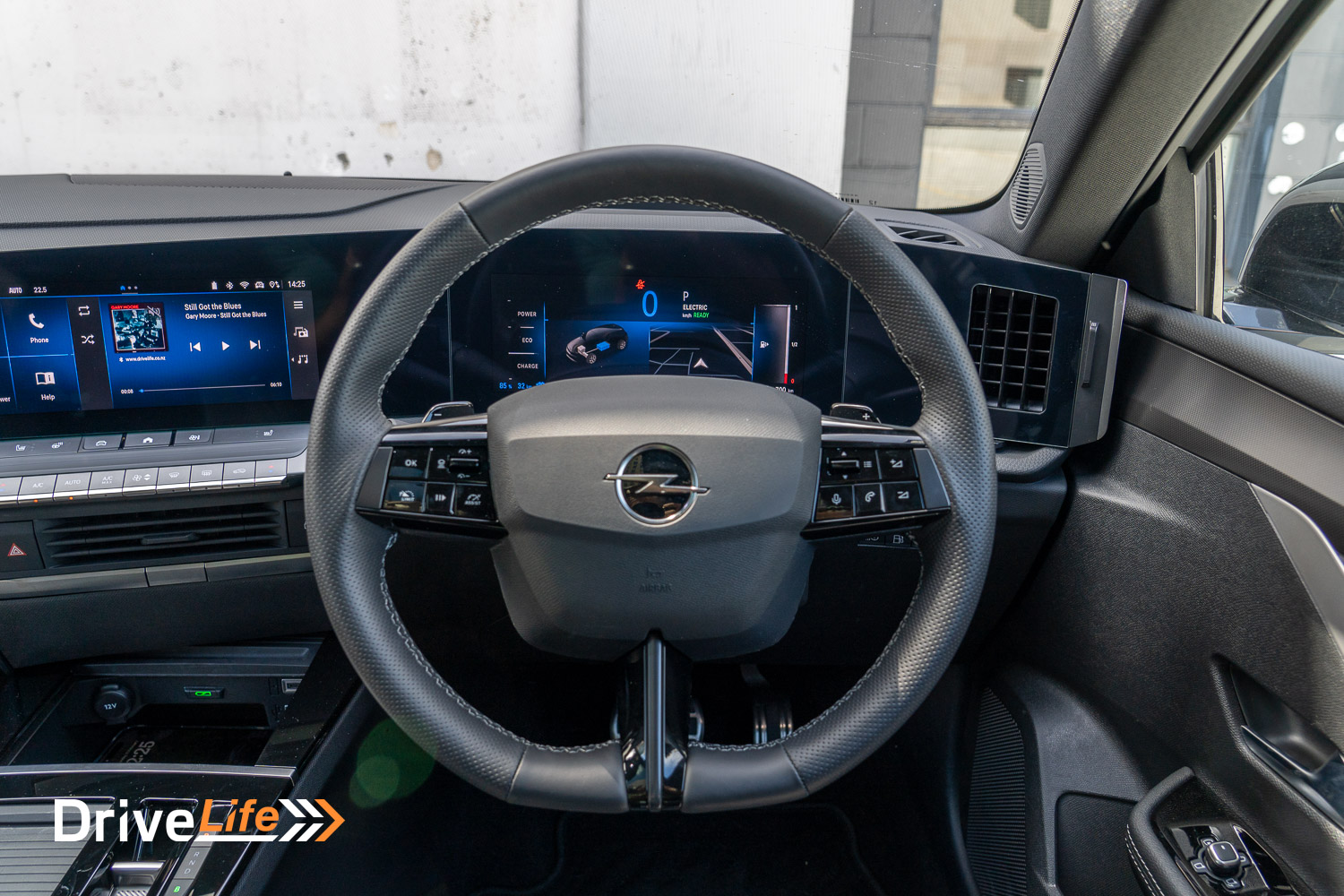
On pulling away from the dealership with the Astra in Electric drive mode, performance is good – easily enough for daily driving. For my test, I am going to charge the car whenever I can, within reason. I would expect that any PHEV owner is going to take the opportunity to charge their car, and so will I. This should mean that I match Opel’s claim on 1.0L/100km.
As the days went on, that EV-only range would increase to eventually 56km; that’s a good number, but my average was around 45km on a full charge. Keep in mind that Wellington’s hills suck EV range, so even seeing 56km was surprisingly good.
Another bonus point for the Astra GSe is that it remembers your drive mode. I can’t remember if I have ever seen any car that does this, so finally we are seeing some common sense here – from an Opel! This means if you have the car set to Electric drive mode and then get out when you get back in again, it’s still in Electric mode. Hallelujah! I’ve been waiting so long for this to happen and to be honest, I never thought it would. For me, it meant I could drive the car in Electric mode as often as possible without the petrol engine starting.
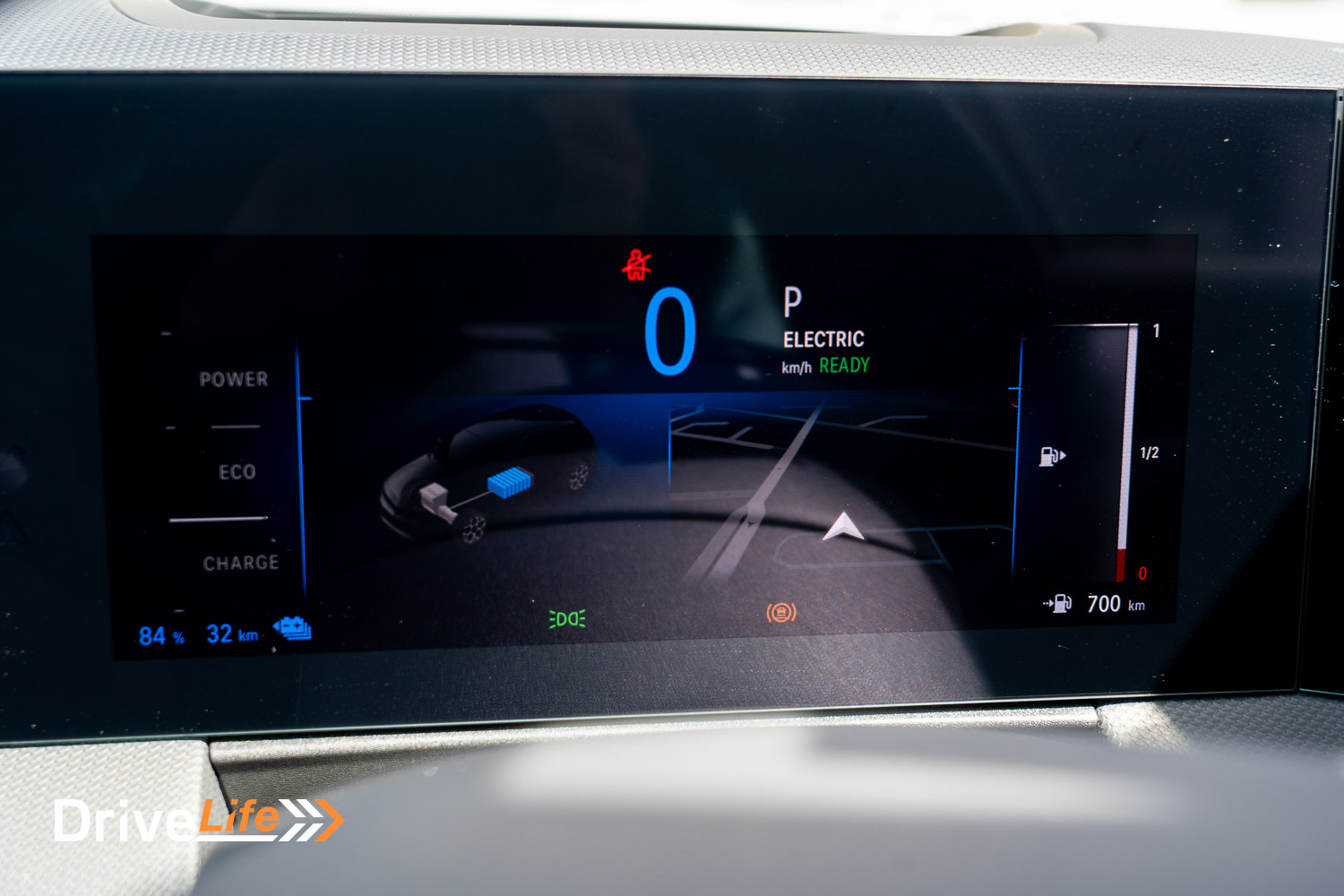
The same goes for the other drive modes, Hybrid and Sport. These are also remembered when you lock the car.
Regarding the drive modes, Opel says:
The driver can determine the driving style by selecting one of the following modes:
- Hybrid: offers the best of both worlds between controlled fuel consumption and on-road performance
- Sport: draws on the combined power of the engine and motor for a more dynamic drive
- Electric: activates the electric motor only, for zero CO2 emissions and complete silence
- Engine sound enhancement: In the Sport mode, the engine sound is amplified via the radio speakers depending on input factors such as vehicle speed, engine speed, acceleration, gear and pedal position
If you are running the Astra GSe in Electric mode and floor the gas pedal, the petrol engine will start to give you extra performance. Once you’ve settled down, the petrol engine will shut down again and you can continue driving only using battery power. Like other PHEVs, the car has a ‘Save’ mode where you can run the petrol engine and it will charge the battery up. Unfortunately, you can only access this by going through some menus in the infotainment system, so I doubt many owners would bother. This is mainly for cities that have zero-carbon zones, so not as applicable here.
Hybrid mode does what it says on the box and while I suspect many owners will leave their Astra in Hybrid mode, I was going for maximum fuel economy. My daily commute is around 40km to the office, where I could charge the GSe, and then 40km back, where I could plug it in overnight. With just a 12.4kWh battery pack, it doesn’t need overnight to charge. With a home ‘wall’ charger, it’s less than 2 hours, or if you are using the supplied ‘normal’ home charger, it will take around 7 hours from flat to full.
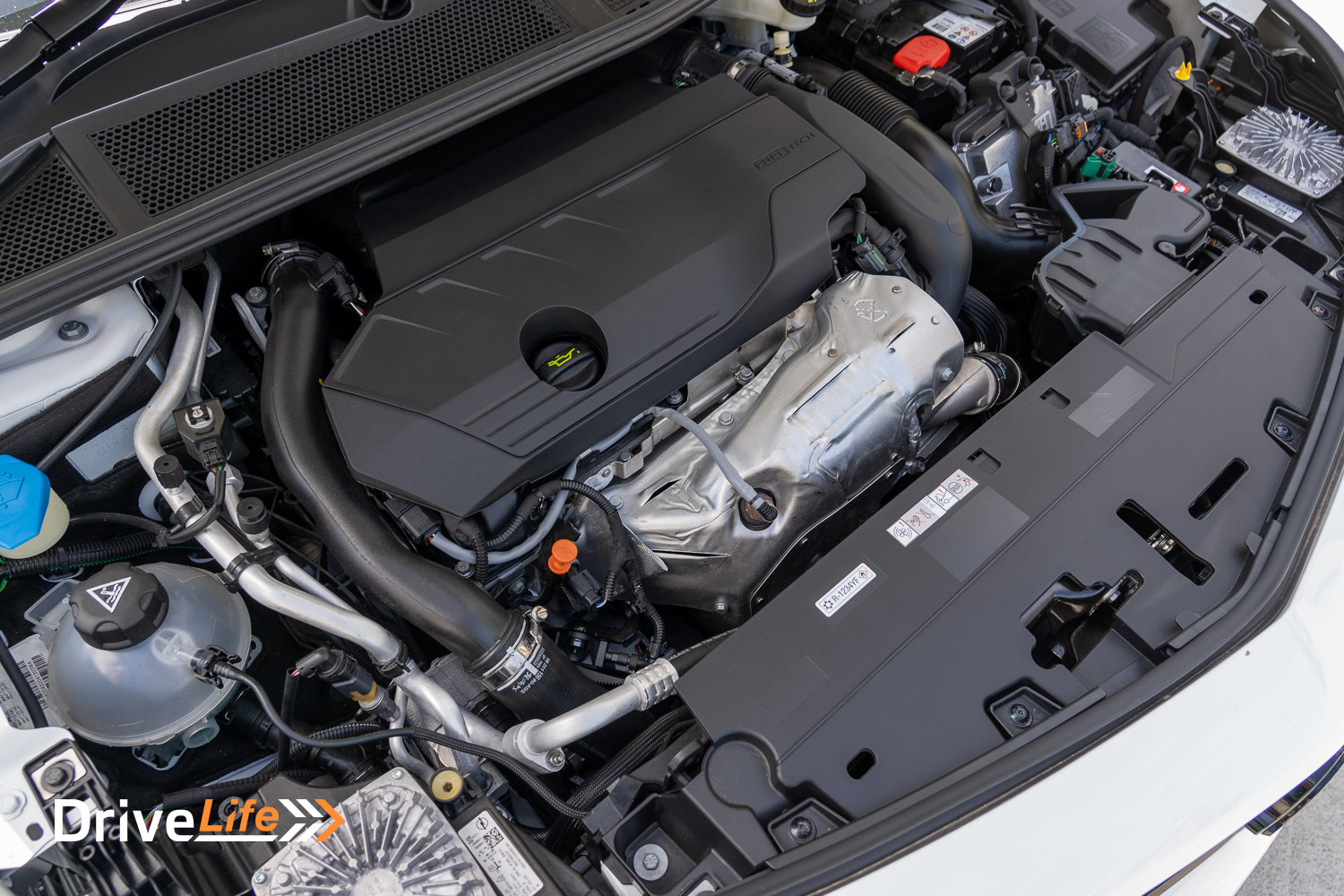
Time to talk about Sport mode. The Astra GSe has some mighty fine performance when you slip it into Sport mode. You get access to a combined 165kW of power, and that means a 0-100km/h time of 7.5 seconds. That’s damn good for what is essentially a 5-door family hatchback. The car will top out at 235km/h, not that that matters in New Zealand. Anytime, anywhere in Sport mode, the Astra GSe leaps forward with total eagerness. Want to spin the tyres? Floor it, job done – not that you should be doing that, of course. Those mums and dads who like to safely carve up a country road with a bit of pace will find the performance of the Astra GSe quite rewarding.
On those back roads, another huge bonus of using that Peugeot/Citroen platform is revealed: its road holding and handling are excellent. The car is always poised, even if you hit a decent bump mid-corner. It feels good too, with nice feedback from the steering – you always know what the front wheels are doing. Grip through a bend is excellent, and you can really push this car to its limit and still feel in control. It’s superb and a joy to drive on a winding road.
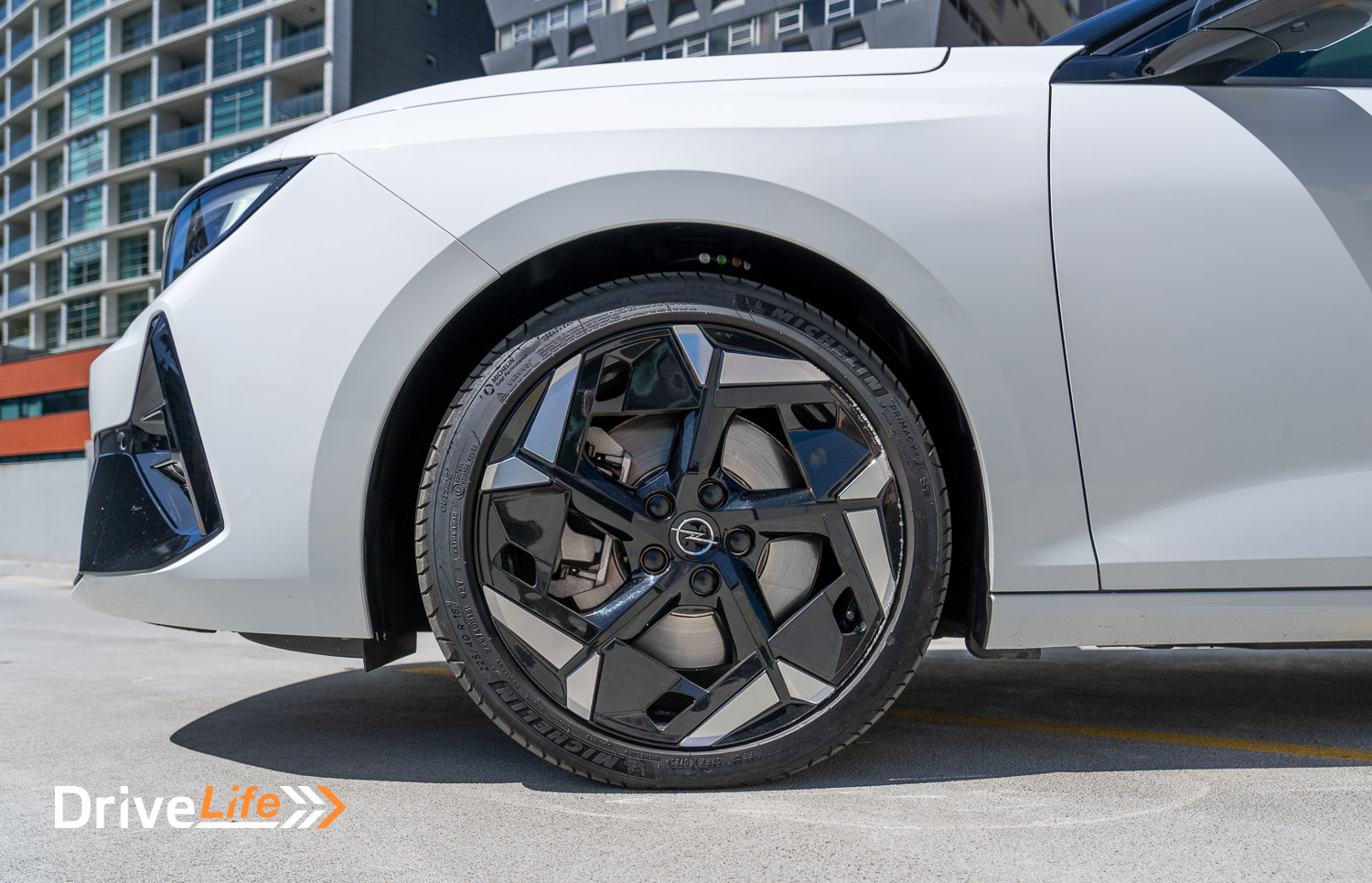
To be honest, we got the same experience out of the Peugeot 308, so that was to be expected. But it’s nice to know the Astra GSe has not been played with too much in the suspension and steering department, and all is well. The GSe runs Michelin Primacy 4 tyres, and these are known for their economy-driving attributes, not handling. Bonus points to the Astra GSe in the handling department.
You would think with decent handling and low profile tyres, the ride would be pretty hard, but it’s certainly not. It’s one of the car’s highlights, and again, to be expected of the EMP2-V3 platform the car is born from.
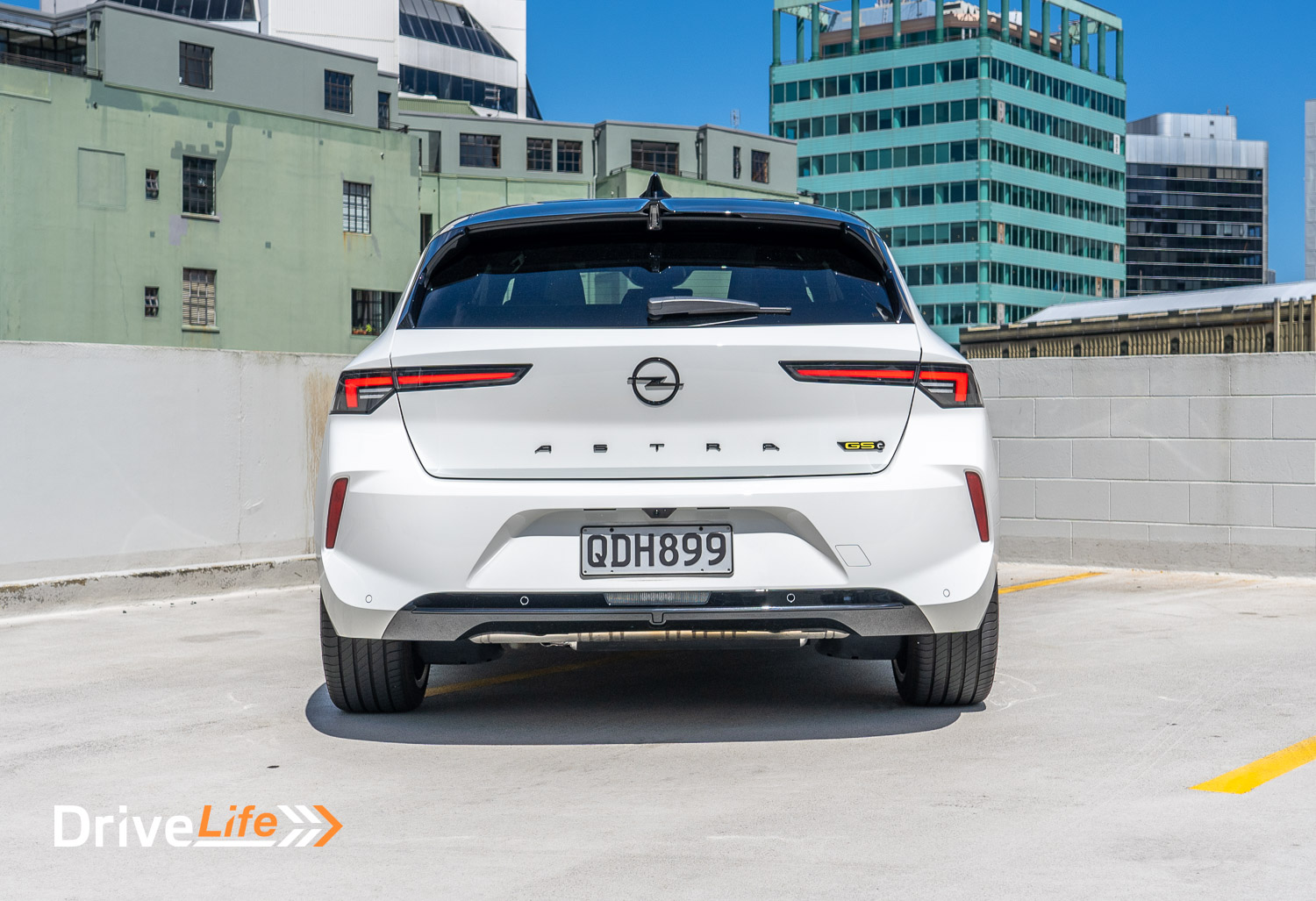
We recently reviewed the Mazda CX-60 PHEV and found that since Mazda had put the electric motor between the engine and gearbox, this led to some surprising drivetrain shunting, which is the opposite of the refinement we’ve come to expect from Mazda. While testing the Astra GSe, I couldn’t help but feel that in Electric mode, the car was changing gears – it is almost imperceptible, but it sure felt like it. On checking this, I found that the Astra GSe has an “electrified transmission”. That sounds weird, but this is what Opel says of their electric gearbox:
The 8-speed electrified transmission system is standard and offers a smooth transition between gears. The 8-speed electrified gearbox includes the following content:
- Multi-disc wet clutch replaces the removed torque converter
- Permanent electric motor that transforms electric energy into mechanical drive energy
- Electric motor installed into the gearbox and petrol engine
- Comes with an intuitive and stylish automatic gearbox with electric shifter with shift paddles
I’m not sure what to imagine when Opel calls it a “stylish automatic gearbox”, but the result is that yes, the car does change gears when using Electric mode but as mentioned, you can barely feel it. After the CX-60 experience, the Astra GSe shows how it should be done. It’s smooth, and it’s good.
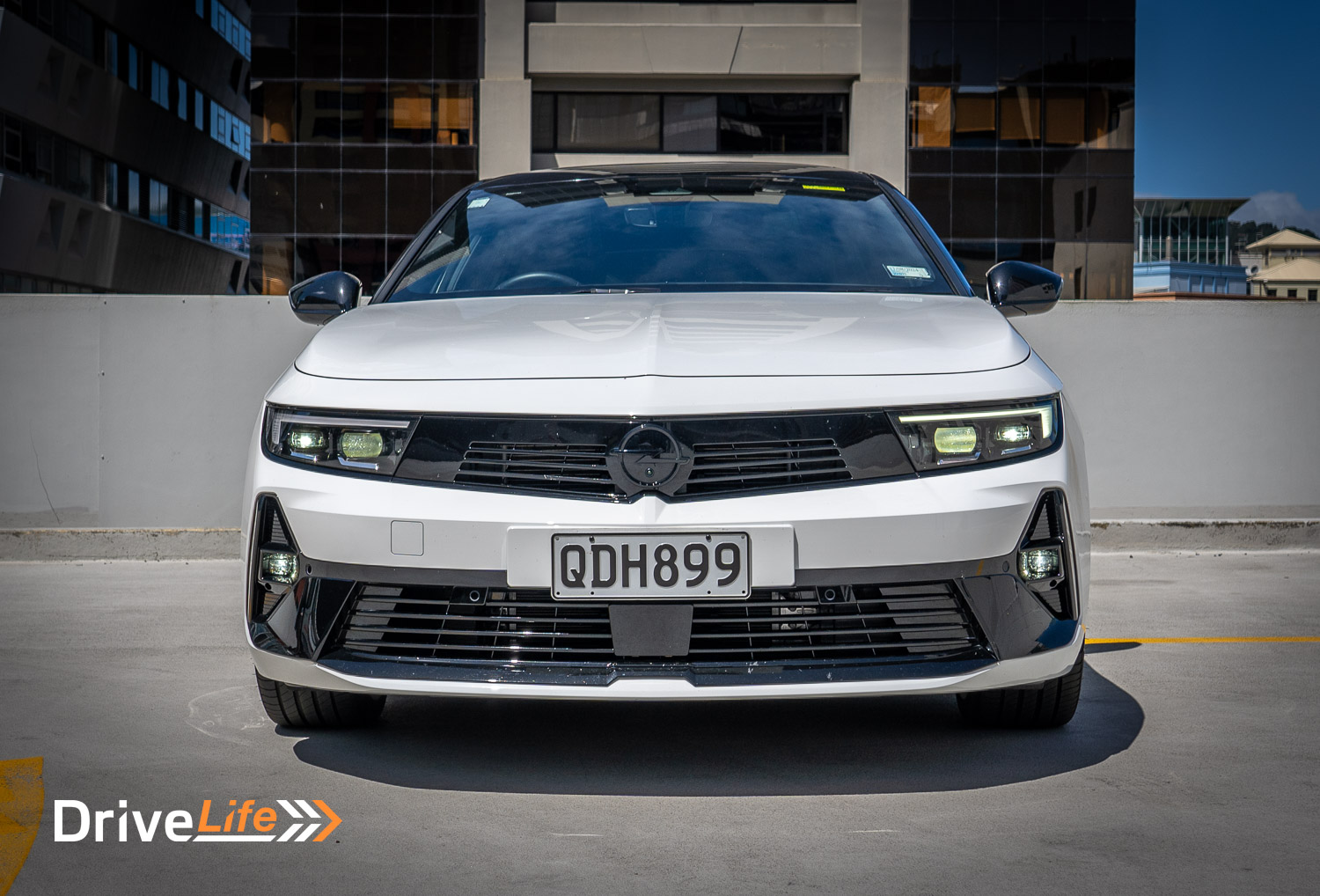
While the Astra GSe has shifter paddles, these have no bearing on the electric regeneration (regen). Instead, there is a ‘B’ button down by the gear selector and this turns on the brake regen. As far as brake regen goes, it’s fairly light but better than nothing. It would have been great to have the paddles changing the amount of regen, but they don’t.
So, the Astra GSe is an impressive driving car on back roads, but what about Daily Driving? What’s it like on the commute to the office and back? Generally, it’s very good. A heads-up display (HUD) is standard and much appreciated. I like that the digital speedometer in the HUD has blue digits; they stand out better against the road and are a bit more visible when using sunglasses that are polarised (the information on any HUD goes away almost completely when wearing polarised sunglasses), so this is a bonus. As you’d expect, if using the car’s built-in SatNav you will see the directions shown on the HUD. While I enjoy using Apple CarPlay, you don’t get that option and ditto for Android Auto.
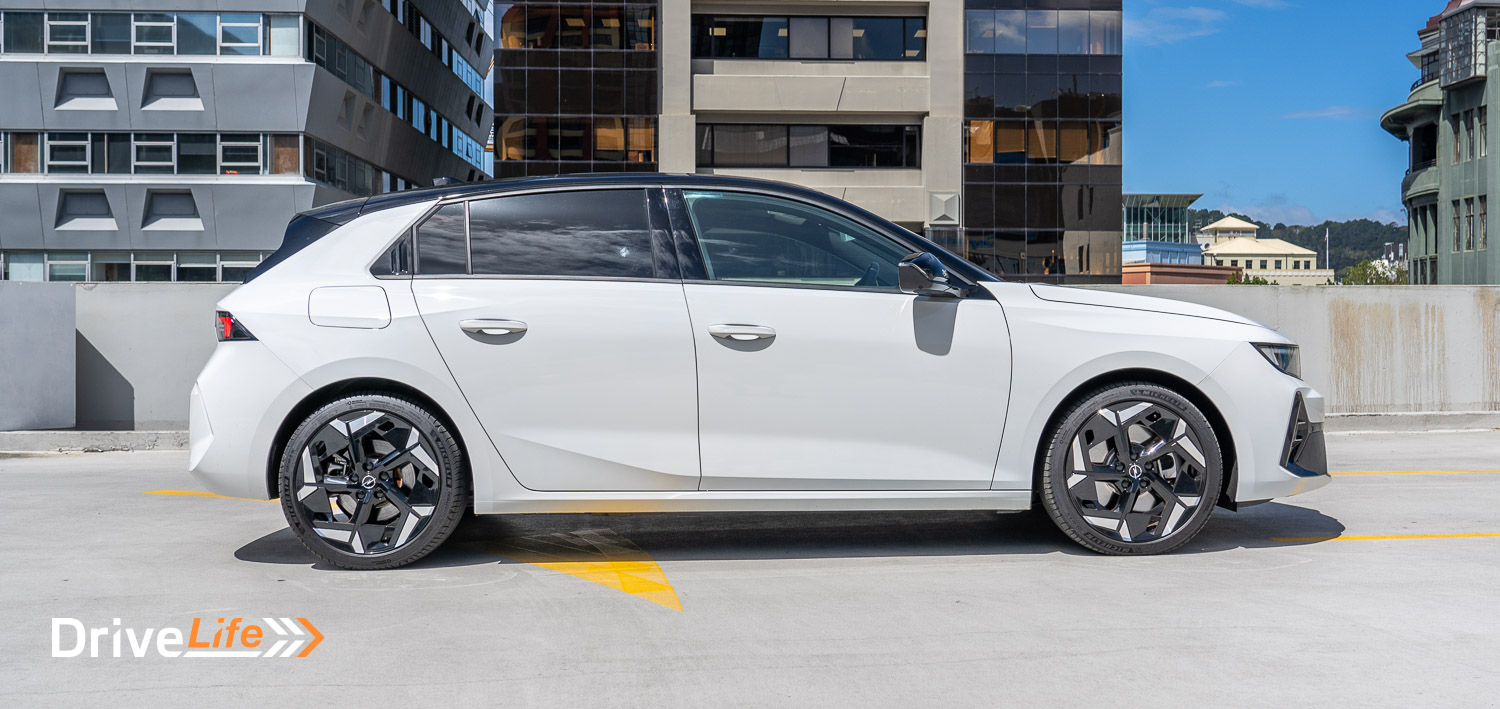
A highlight of the car is the tight turning circle, at just 10.5 metres. It’s another reason that makes the Astra GSe a handy commuter. Add to this a 360-degree camera system that is sharp and clear, and Daily Driving the Astra is a doddle.
General visibility out of the car is good, although that large C-pillar will block your three-quarter vision – but there is long-range blind spot monitoring in place. The driving position is very good, it’s easy to get it just right. If you need to floor it or decide to run the car in Sport mode where the engine is running all the time, you’ll find the engine is fairly quiet and smooth. For some reason, I was expecting it to be a bit coarse, but it’s far from it. If in Sport or any mode, there is no rev counter at all. This is a surprising omission from the car. Not the end of the world, but if you are using the paddles to change gear in Sport mode, there is no way of knowing what the engine is doing other than by the sound it is making.
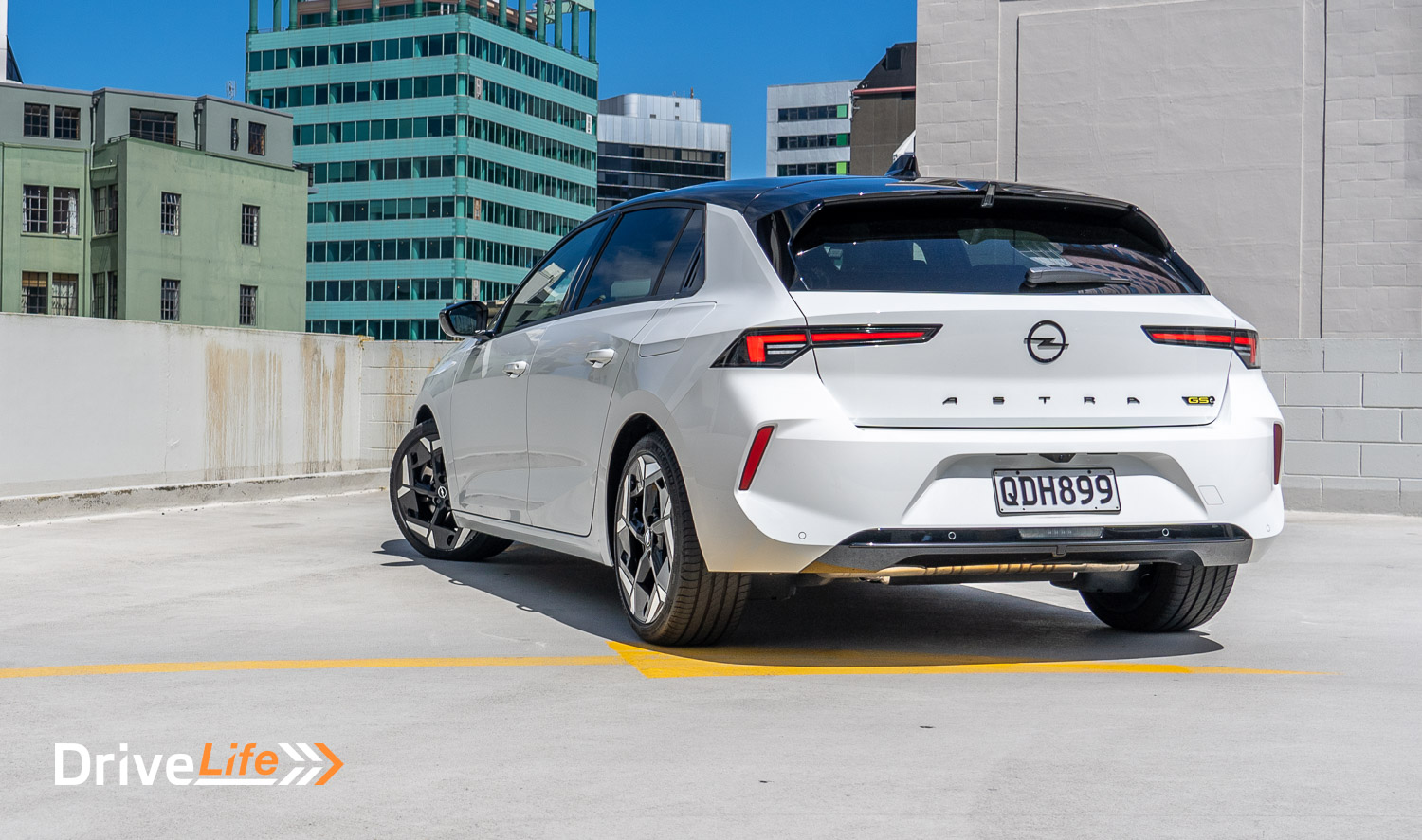
Adaptive cruise control is standard, and it works well. After getting out of a Hyundai Kona with its slow-to-respond adaptive cruise, the Astra’s worked very well. You can also use the ‘ok’ button on the steering wheel to set the adaptive cruise control speed to the current speed limit, and this also works if you are using the speed limiter. It’s a nice, smooth adaptive cruise system and I used it often. Steering assist is also fitted to the car, and you engage this with the adaptive cruise control button on the steering wheel. It’s one tap of the button to engage adaptive cruise, and another tap to turn on steering assist. The steering assist system is pretty reliable – not once did I have it trying to exit the motorway on an off-ramp, for example. It did tend to hug the centre line too much for my liking, but this is a common issue with steering assist systems.
On the not-so-good side of things, traffic sign recognition is fitted to the Astra GSe, but it only appears in the HUD. So if you are wearing polarised sunglasses, the current speed limit disappears from the HUD. The Astra GSe has an electric park brake but is not fitted with brake auto-hold. This is a common item missing across Peugeot and Citroen models too, and it’s a real shame they haven’t fitted it.
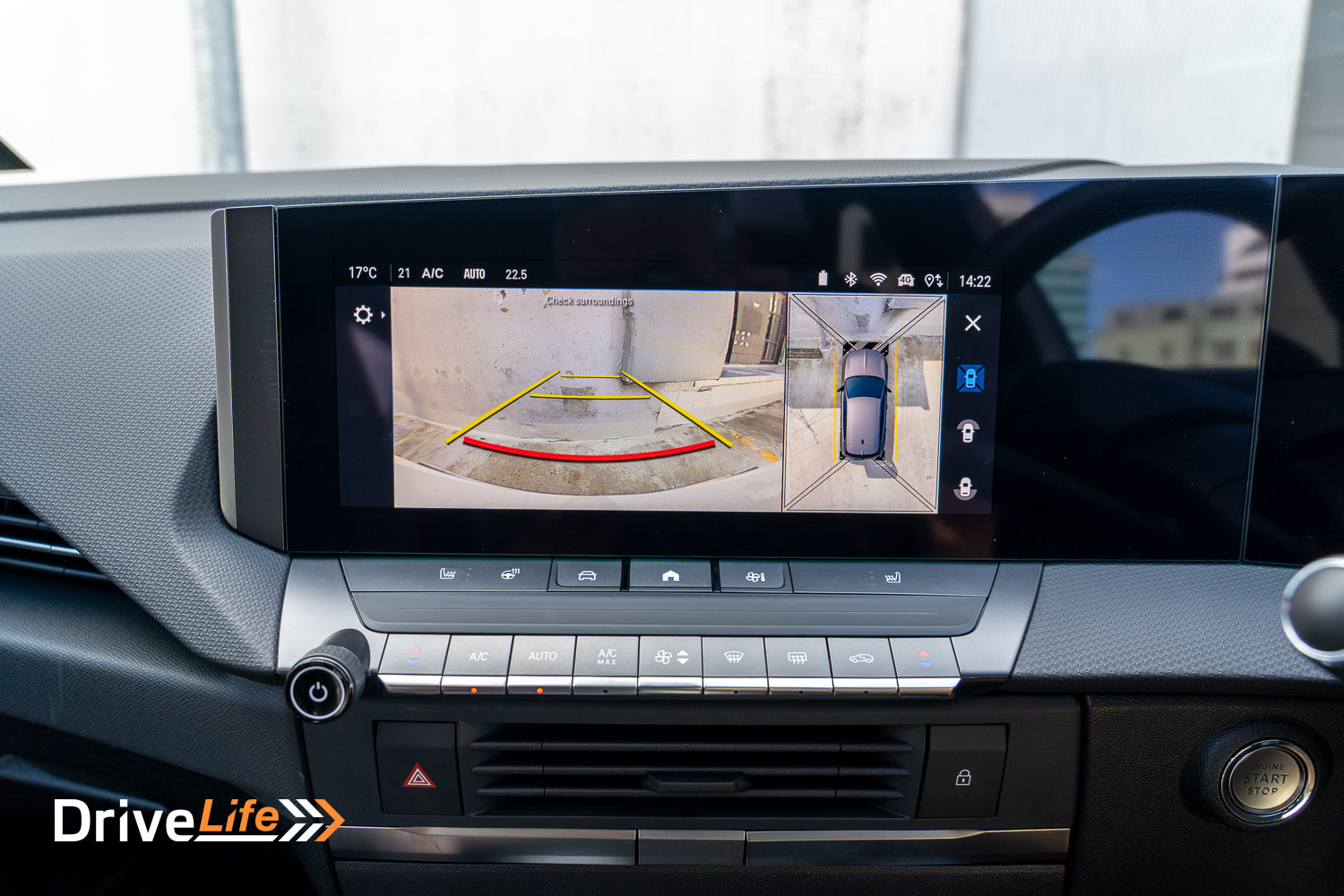

At the end of the day, PHEV buyers are after fuel economy and range. Although I did a total of just under 500km in the Astra GSe, after 300km driving I still had 660km range left – bear in mind I started with 700km range. That’s pretty damn impressive.
While Opel states the Astra GSe should do 1.0L/100km, I managed to use just 0.9L/100km over 500km. As mentioned, this was using it as a PHEV owner should; I charged it at home at night, and I charged it at the office. I realise not everyone can charge at the office, but I was pretending to be a PHEV owner and they would do that if they could.
I’d like to let you know what the energy economy of the car is, but for the first time in any car that is an EV or PHEV, there is no way of knowing. The best the Astra GSe can give you is the last 90 minutes of driving or an instant figure. Hopefully, we’ll see this fixed in an update.
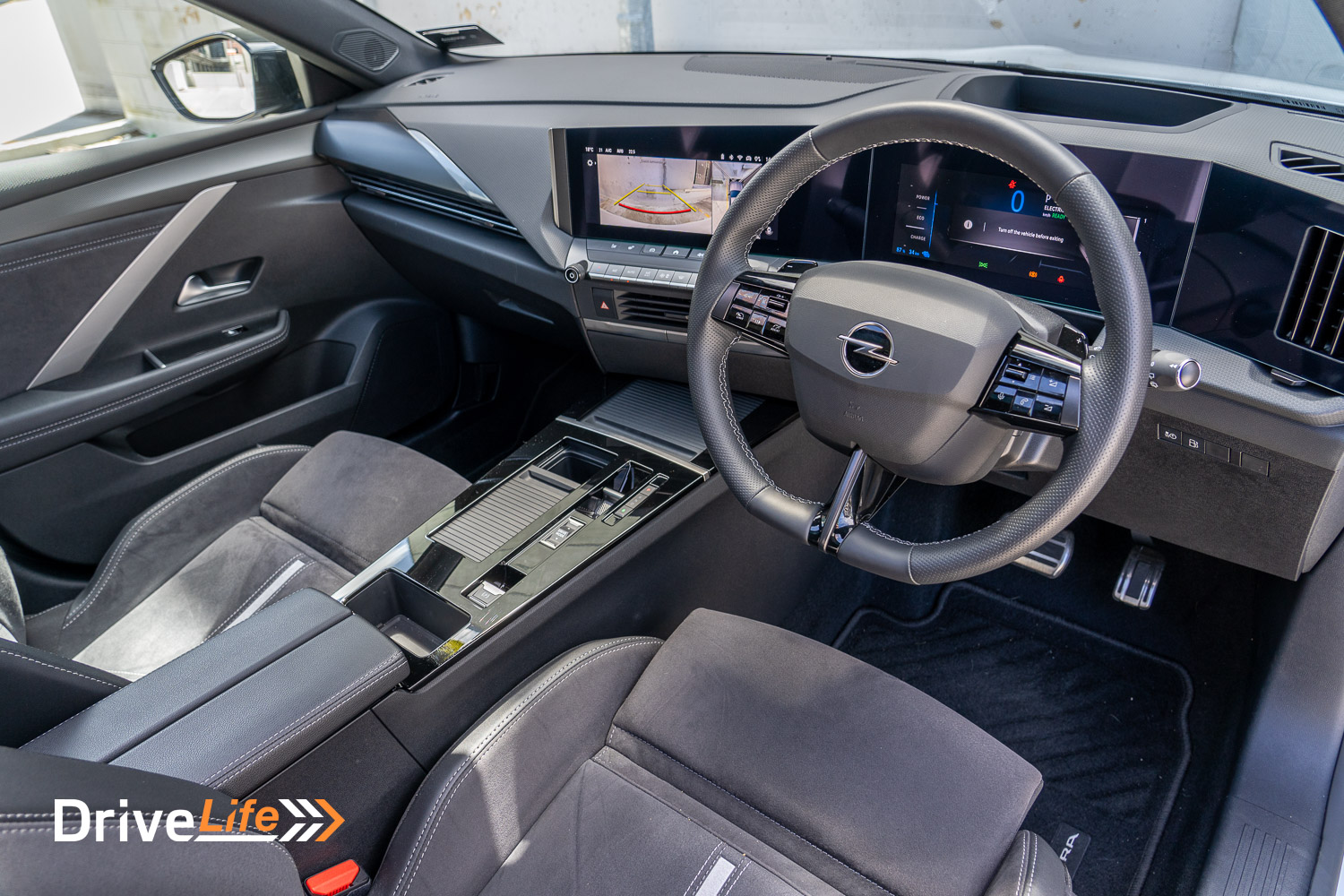
And the running costs? Using a current average fuel cost of $2.95/litre, that equates to $26.55 over 1,000km of driving. The current cost of a PHEV for road user charges is $53/1,000km for a total of $79.55. But let’s not forget the cost of electricity. At home, I pay 22 cents/kW no matter what the time of day. It’s hard to work out how many kWh/100km the Astra uses as the car doesn’t tell you, but if we go for a guess of 18kWh/100km, that is 180kWh of power used over 1,000km of driving for a cost of $39.60. That means a total cost of $119.15 for the PHEV to travel 1,000km.
What about the equivalent of petrol? Let’s use the Astra SRi for comparison; it has a 1.2-litre engine and uses 5.1L/100km and although this is the manufacturer’s figure and not real-world, we’ll use it anyway. That’s 51 litres of fuel over 1,000km and while the SRi would use 95 fuel we’ll use the cost of 91 fuel to keep it consistent. That means a total cost for petrol of $150.45, a saving of just $31.30. Ouch. Yes – less carbon emissions and less maintenance, but you sure aren’t buying a PHEV to save money in the long run.
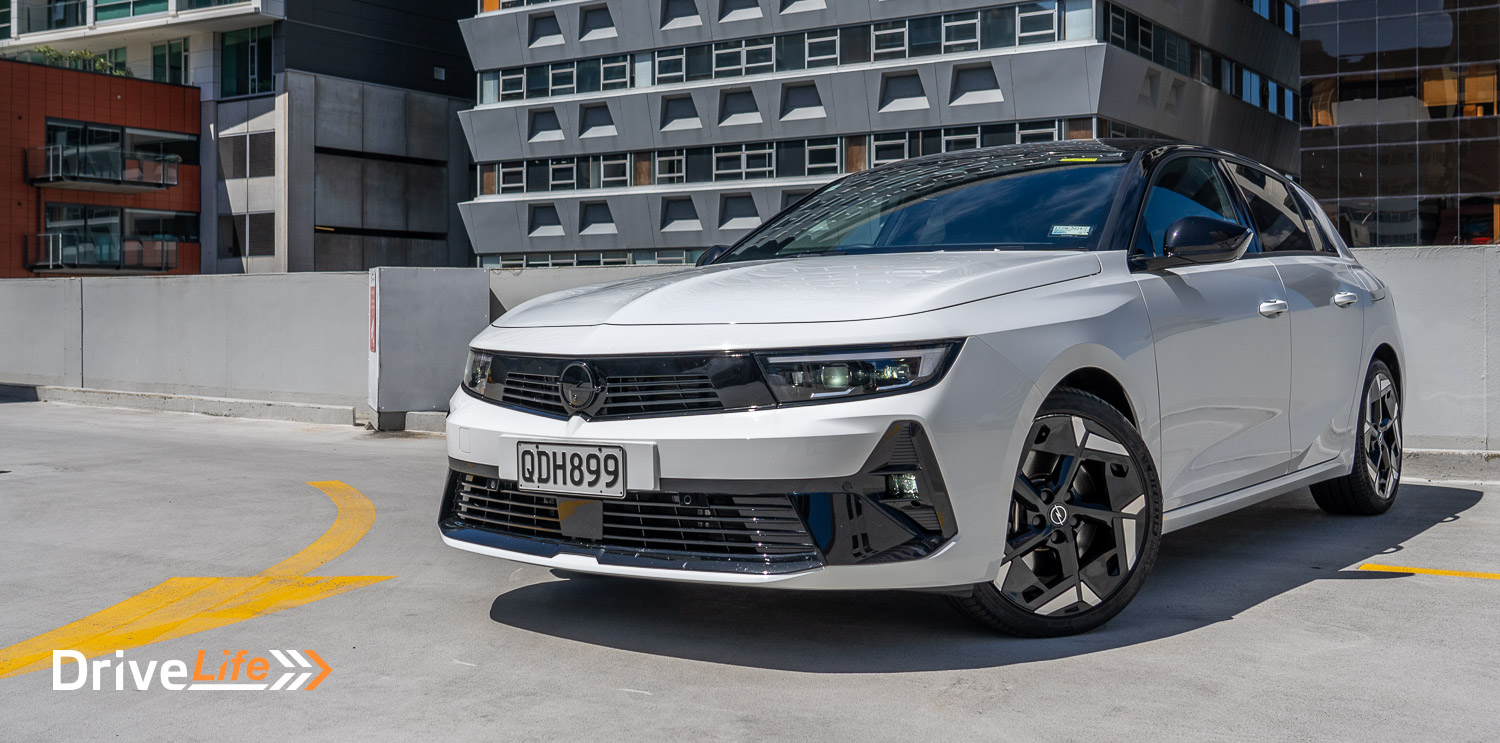
2024 Opel Astra GSe – Specifications
| Vehicle Type | 5-door hatchback |
| Starting Price | $71,990 |
| Price as Tested | $72,540 |
| Engine | 1.6-litre, 4-cylinder petrol Single electric |
| Power, Torque kW/Nm | Petrol: 165/360 Electric: 81/320 |
| Transmission | 8-speed automatic transmission |
| Spare Wheel | Puncture repair kit |
| Kerb Weight, Kg | 1,628 |
| Length x Width x Height mm | 4374x1860x1441 |
| Boot Space / Cargo Capacity, Litres (seats up/seats down) | 352/1,286 |
| Fuel tank capacity, litres | 42 |
| Fuel Economy, L/100km | Advertised Spec – Combined – 1.0 Real-World Test – Combined – 0.9 Low Usage: 0-6 / Medium Usage 6-12 / High Usage 12+ |
| Towing Capacity Kg, unbraked/braked | 750/1,450 |
| Turning circle metres | 10.51 Small: 6-10m / Medium 10-12m / Large 12m+ |
| Warranty | 5-year, 100,000km Warranty 5 years Roadside Assistance |
| Safety information | ANCAP Rating – 4 stars – Link Rightcar.govt.nz – 5 Stars – QDH899 |
Have you enjoyed this review? Be sure to join our monthly email newsletter list so you don’t miss a single car review.


